Still have questions? Leave a comment
Add Comment

Checklist: Dissertation Proposal
Enter your email id to get the downloadable right in your inbox!
Examples: Edited Papers
Need editing and proofreading services, apa title page format simplified | examples + free template.

- Tags: Formatting
The 7th edition of the APA title page (introduced in 2019) has separate formatting guidelines for student and professional research papers. It replaced the APA 6th edition, which was introduced in 2009. The APA 7 formatting guidelines allow for more flexibility when it comes to font size and style.
If you have questions about how to format your cover page, this article is for you. We will be taking a look at the formatting guidelines for the APA style cover page for students as well as professional papers. In order to help you create an appropriate cover page, we’ve also included an APA 7 title page template and plenty of APA cover page examples.
What is the title page for an APA paper?
The APA title page is the first page of your academic paper that provides information on the title, author(s), professors, and institutions affiliated with your research paper. There are separate APA cover page formats for student and professional papers.
An APA 7 title page consists of the following components:
Student paper
- Page number*
- Title of the paper
- Name of author(s)
- Institutional affiliation
- Name and number of the course
- Name of professor(s)
- Date of submission
*A running head (shortened version of the title) is generally not required for student papers unless explicitly stated by the professor.
Professional paper
- Page number
- Running head
- Institutional affiliation(s)
- Author note (Author’s ORCID iD, affiliation changes, disclosures of conflicts of interest, and the author’s contact information)
Now that we’ve gotten a gist of the APA title page format, let’s understand how to construct cover pages for both these versions in detail.
How to construct an APA title page
Before you start formatting the APA first page, there are a few ground rules you must consider. Here are the rules for formatting an APA title page:
- Leave a one-inch margin for all pages.
- Use double spacing throughout your cover page.
- Maintain consistency in font size and style.
- Avoid using any titles (Dr, Prof) or degrees (MA, PhD).
- Include the running header and the page number on the top left and right corners respectively. (Simply include the page number for student papers.)
- After leaving 4–5 lines, input and centrally align the title of your paper.
- Include the first, middle, and last name(s) of the author(s) respectively, exactly below the title.
- Include the name of the affiliated university/universities below the names of the authors involved.
- For student papers, include the name of the course professor and the due date below the affiliated university.
- For professional papers, include the author note a few lines below the affiliated university/universities.
- The author note should be bolded and centrally aligned.
- Details such as the author’s ORCID iD, contact information, affiliation changes, and disclosures of conflicts of interest should be right aligned and placed under the author note.
The APA 7 format is pretty flexible when it comes to the font style. You can use any of the following font styles in your paper:
- 12-point Times New Roman
- 11-point Calibri
- 11-point Arial
- 10-point Lucida Sans Unicode
- 11-point Georgia
- 10-point Computer Modern
Now, let’s take a closer look at how to construct the individual elements of both student and professional versions of APA 7th edition title pages:
The following APA cover page examples will help you locate the exact position of each component. These examples cover both, student and professional papers and will guide you in constructing your own cover page. We’ve labeled each of these components and will guide you on how to format them.
Here are the main components of the above APA title page examples:
1. Page number
The page number in an APA style title page should be present on the top right corner of each page and the title page should always be considered page number “1”.
Follow these steps to correctly format the page number in Microsoft Word:
- Activate the header by double-clicking on the top of the page.
- Click on the “Insert” tab.
- Select the “Page numbers” option.
- Hover over “Top of Page” and select “Plain Number 3”.
Once this process is complete, you should have a page number for all your sheets.
2. Running head
A running head consists of the title of your paper in all caps. It is compulsory when it comes to professional research papers, but is generally not mandatory for student papers.
The running head should be in line with the page number, left aligned, and under 50 characters long (including spaces). If your title is longer, you’ll have to shorten it so it can fit the character count of the running head. Make sure to include the main idea of the title here and exclude the less important parts.
Here’s an example of an APA format title along with the running head:
Passing the Genetic Torch: Examining the Mechanisms of Genetic Variation
EXAMINING THE MECHANISMS OF GENETIC VARIATION
3. APA title
The title of your APA cover page must be succinct, informative, and eye-catching. It should also contain the relevant keywords of your paper, essentially providing a gist of your paper. Although not mandatory, it is a good idea to limit your title to under 12 words.
Here’s how to create your APA format title as per the specified guidelines:
- Position your title 4–5 lines from the top of your page.
- Select your title to centrally align and bold it.
- Use the title case* while creating your heading.
*Capitalize the first letter of each word apart from articles and prepositions.
4. Name of the author(s)
After adding your title, mention the name of the authors under the title of the paper (leave a blank line in between). The APA formatting guidelines for the names of authors are different for student and professional papers.
Take a look:
Student papers
Student papers only include the names of authors involved in the process of writing the paper.
- Make sure to include the first, middle, and last names of the authors in precisely this order.
- In the case of two authors, separate the names with an “and”.
- In the case of three or more authors, separate each name with a comma and input the last name with an Oxford comma as well as an “and”.
- Don’t mention titles such as “Dr” and “Prof” or degrees such as “MA” and “PhD”.
Professional papers
The names of authors in professional papers follow similar guidelines to those of student papers. However, they do include a few additional elements.
- In the case of multiple affiliated institutions, use superscript numbers after the names of the authors.
5. Institutional affiliations
An author’s institutional affiliation is placed below their name on an APA cover page.
- Add the department and university name, separated by a comma.
- In the case of multiple affiliations, mention the institutions corresponding to each author in the order of their names.
- Add a superscript number before the name of each institution to indicate the corresponding author.
6. Name and number of the course
It’s mandatory to include the name and number of the course for student papers .
- Align the information centrally and place it below the institutional affiliation.
- Write the course number in all caps followed by the course name and separate them by a colon. (For example: HISTORYLIT303: Historical Writing)
- Write the name of your course professor below the course name and number and align it centrally.
- Include the designation as well as the first and last name of your professor.
7. Author note
Professional papers often contain an author note.
- Place the “Author Note” label at the bottom half of the page, bolded and aligned centrally.
- Add an indent of 0.5 inches for all entries in the author note and align them to the left.
- Follow the author’s names with their ORCID iDs.
- Mention any changes in the authors’ affiliation.
- Disclose any conflicts of interest.
- Add the authors’ contact information.
8. Date of submission
The date of submission for the paper is only to be included for student papers and should be placed below the professor’s name.
- Centrally align the date of submission using the “Month, Day, Year” format.
- Spell out the month and avoid abbreviating it.
- Include the complete year instead of just the last two digits.
Here’s an example: October 02, 2023
APA 7 title page template
Our expertise in providing superior paper editing services has helped us create an APA 7 title page template for students and research professionals. These templates are written using the 12-point Times New Roman font. They also follow all the guidelines for an APA 7 cover page that we’ve highlighted above.
APA 7 Title Page Template for Students
APA 7 Title Page Template for Professionals
Found this article helpful?
Leave a Comment: Cancel reply
Your email address will not be published.
Your vs. You’re: When to Use Your and You’re
Your organization needs a technical editor: here’s why, your guide to the best ebook readers in 2024, writing for the web: 7 expert tips for web content writing.
Subscribe to our Newsletter
Get carefully curated resources about writing, editing, and publishing in the comfort of your inbox.
How to Copyright Your Book?
If you’ve thought about copyrighting your book, you’re on the right path.
© 2024 All rights reserved
- Terms of service
- Privacy policy
- Self Publishing Guide
- Pre-Publishing Steps
- Fiction Writing Tips
- Traditional Publishing
- Additional Resources
- Dissertation Writing Guide
- Essay Writing Guide
- Academic Writing and Publishing
- Citation and Referencing
- Partner with us
- Annual report
- Website content
- Marketing material
- Job Applicant
- Cover letter
- Resource Center
- Case studies
- The Complete Guide to APA Format in 2020
APA Title Page / Cover Page
- Headings and Subheadings
- Discussion Section
- Websites and Online Sources
- Journals and Periodicals
- Other Print Sources
- Other Non-Print Sources
- In-text Citations
- Footnotes and Endnotes
- Using MyBib Responsibly
- Miscellaneous Questions

Details to include
The title page (also known as the cover page) is the front page of your paper. It should contain:
- The running head , a header at the top of the page.
- The first page number .
- The title of the paper
- The institution for which you writing.
Running head
The running head should be in the top-left corner of the page in uppercase. It should include a shortened title of your paper. On the front page only, it should also be prepended with "Running head:".
First page number
The first page number -- generally page 1 -- should be in the top-right corner of the page. Both the page number and the running head should be a half inch from the top of the page.
The title of the paper can contain upper and lowercase letters, and ideally should be no more than 12 words in length. It should be direct, and should not contain abbreviations or other unnecessary words. It should not span longer than 2 lines. The first letter of each word should be uppercase, except for articles (a, an, the), and conjunctions (and, but, for, or, yet).
Underneath the title should be your name (or the author's name if you're not the author). It should be displayed as the first name , middle initial , and last name . Do not add titles (such as Dr.) to the beginning, or qualifications (such as PhD) to the end of an author's name.
Your institution
Finally, underneath the author's name, state the full name of the institution or school you're writing the paper for.
The font for all text on the title page should be Times New Roman, size 12pt, with double line-spacing.
A correct title page will look like the below image:

After completing your title page you will move on to writing an abstract of your paper.
APA Title Page (Cover Page) Format, Example, & Templates
Saul Mcleod, PhD
Editor-in-Chief for Simply Psychology
BSc (Hons) Psychology, MRes, PhD, University of Manchester
Saul Mcleod, PhD., is a qualified psychology teacher with over 18 years of experience in further and higher education. He has been published in peer-reviewed journals, including the Journal of Clinical Psychology.
Learn about our Editorial Process
Olivia Guy-Evans, MSc
Associate Editor for Simply Psychology
BSc (Hons) Psychology, MSc Psychology of Education
Olivia Guy-Evans is a writer and associate editor for Simply Psychology. She has previously worked in healthcare and educational sectors.
On This Page:
In APA Style (7th edition), the cover page, or title page, should include:
- A running head (professional papers only) and page number
- The title of the paper
- The name of the author(s)
- The institutional affiliation
- An author note; optional (professional papers only)
- A student paper should also include course information
Note : APA 7 provides slightly different directions for formatting the title pages of professional papers (e.g., those intended for scholarly publication) and student papers (e.g., those turned in for credit in a high school or college course).
Professional paper APA title page

Student paper APA title page

Formatting an APA title page
Note : All text on the title page should be double-spaced and typed in either 12-point, Times New Roman font. In the 7th edition, APA increaded the flexibility regarding font options: which now include Calibri 11, Arial 11, Lucida Sans Unicode 10, Times New Roman 12, or Georgia 11. All words should be centered, and capitalize the first letter of important words.
Running Head
In the 7th edition of the APA style manual, running heads are only required for professional papers that are being submitted for publication (student papers do not require a running head, but still need a page number).
Your title page should contain a running head that is flush left at the top of the page and a page number that is flush right at the top of the page.
Place the running head in the page’s header:
- The running head is the abbreviated title of the paper (IN UPPERCASE LETTERS) aligned left on the page header of all pages, including the title page. APA (7th edition) guidelines require that running heads be a maximum of 50 characters (spaces count as characters).
- The “Running head:” label used in the APA sixth edition is no longer used.
- Place the page number in this same header, but align right, beginning with page number 1 on the title page.
- This header should be 1 inch from the top. Some instructors allow for 1/2 inch, too, but the default is 1 inch.
Paper Title
Position the title of the paper in the upper half of the page. The title should be centered and written in boldface, and important words should be capitalized.
The APA recommends that your title should be a maximum of 12 words and should not contain abbreviations or words that serve no purpose.
Author Name(s)
Institutional affiliation.
Position the school or university’s name below the author(s) name, centered.
A student paper should also include the course number and name, instructor name, and assignment due date.
Further Information
- APA Student Title Page Guide
- APA Referencing
- How to Write a Lab Report
- Essay Writing Guide for Psychology Students
- APA Style Citations & References
- Example of an APA Formatted Paper

APA Guide: 7th Edition
- Page Numbers
- Figures/Images
- Webpages and Other Online Content
- Legal Citations
- Writing Style
- Summary of Changes
Student Paper Example
- Student Paper Example This is a student paper example from the 7th Edition of the Publication Manual of the American Psychological Association.
Professional Paper Example
- Professional Paper Example This is a professional paper example from the 7th Edition of the Publication Manual of the American Psychological Association.
Student Title Page Elements
The title page includes the following elements: Page number, Paper title, Author, Author Affiliation, Course, Instructor, and Due Date . Remember, your instructor can include other requirements for your assignment. Refer to their instructions carefully.
Your title page and paper is double-spaced. Use 1-inch margins.
Acceptable Fonts:
- 11-point Calibri
- 11-point Arial
- 10-point Lucida Sans Unicode
- 12-point Times New Roman
- 11-point Georgia
- 10-point Computer Modern 1
- Should summarize the main idea in a succinct way .
- Include strong keywords so that readers can find your work in a database or by using a search engine.
- Avoid using abbreviations in a title.
- The title should be provided in title case . This means that all major words are capitalized.
- Be bolded, centered, and begin 3-4 lines down from the top margin of the paper.
- Put a double-spaced blank line between the title and the byline.
- The paper title also appears at the top of the first page of your paper.
Author Name(s) (Byline)
- Beneath the title, type the author's or authors' full name(s) .
- Do not use titles or degrees.
- Order the names of authors based on their contributions.
- Write all of the names on the same line.
- Center the names in a standard font.
- Smith and Doe
- Smith, Doe, and Jones
Author Affiliation
- Identify where you worked or studied when the body of work was completed.
- Include no more than two affiliations for each author.
- Example: College of Nursing and Health Innovation, University of Texas at Arlington
- Include the department or division.
- Include the name of the institution.
- Include the location of the institution.
- Example: Hematology/Oncology, Cook Children's Medical Center, Fort Worth, Texas, United States
- Include the location.
Locations should include the city, state, province, and country.
Course Name
- Put the course number and name below the Author Affiliation.
- Check with your instructor on the preferred name.
- Place the month, date, and year after the Instructor(s) name(s).
See the example title page below:

All content on this guide comes from the 7th edition of the Publication Manual of the American Psychological Association and from the APA Style Blog.
American Psychological Association. (2020). Publication manual of the American Psychological Association ( 7th ed.). https://doi.org/10.1037/0000165-000
American Psychological Association. (2020, October). Blog . https://apastyle.apa.org/blog
- << Previous: Page Numbers
- Next: Tables >>
- Last Updated: Jul 9, 2024 2:58 PM
- URL: https://libguides.uta.edu/apa
University of Texas Arlington Libraries 702 Planetarium Place · Arlington, TX 76019 · 817-272-3000
- Internet Privacy
- Accessibility
- Problems with a guide? Contact Us.
Home / Guides / Citation Guides / MLA Format / Creating an MLA title page
Creating an MLA title page
If you are writing a research paper in MLA style 9th edition for a class, then you may need to include an MLA format title page. An MLA title page is the cover of your paper, and they aren’t always required. So, how do you make a title page that adheres to the MLA formatting guidelines, and how do you know when you need one?
This page contains all the information you need to know to make the perfect MLA title page, so that you can prove that you are an expert researcher and get the best possible grade. This MLA sample paper will show you how the rest of your paper should be formatted.
Here’s a run-through of everything this page includes:
Title page vs. MLA heading on first page
Title page / cover page, first page: mla heading (no title page), troubleshooting.
The current edition of the Modern Language Association (MLA) handbook does not require a title page , but your teacher, professor, or other reader may require one. In this case, you will need to know the differences between a title page and an MLA heading, and which one to use depending on your reader’s preferences. Other citation styles look slightly different, like this APA title page .
A title page, or a cover page, is a single page that comes before your MLA abstract (if required) and the content of your paper. It introduces your paper and quickly shows a reader the following information about your paper:
- author name (your name, since you wrote the paper)
- course information (if applicable)
It does not include any of the research paper itself.
First page with MLA heading
MLA format recommends adding an MLA heading to the first page of your paper. This contains the same information as a title page, but the information is formatted differently and is on the same page on which your actual research paper begins.
Unless otherwise specified by your instructor or teacher, this should be how you format your first page.
Before you start typing your MLA research paper title page, you will need to gather some information.
What you will need
If you are creating an MLA heading on the first page of your essay instead of a title page, you will need most of the same information, but you will format it differently.
To create a title page, you need to include:
- The name of your high school, college, or university (if applicable)
- The title of your paper
- The subtitle of your paper (if you have one)
- Your first and last name
- Your teacher or professor’s name (if applicable)
- The class name or course number (if applicable)
- The date the paper is due (in “day month year” format)
Formatting guidelines
Follow these formatting guidelines when typing your MLA title page:
- Double-spaced
- Times New Roman font
- Size 12 font
- The first letter of each word should be capitalized, with the exception of very short words such as the, and, of, or, a, an, for, in , etc. However, the first word should always be capitalized.
- Do not include a page number heading on your title page
Step-by-step instructions
Here are the steps you need to take to create the perfect MLA title page:
- At the top of the page, type the name of your high school, college, or university (if applicable).
- Skip down approximately one-third of the page and type the title of your research paper using title case.
- If you have a subtitle, type it on the line following the paper title.
- Skip down to the bottom third of the page and type your first and last name.
- On the following line, type the course name and number (if applicable).
- On the following line, type your instructor’s name (if applicable).
- On the following and final line, type the due date of your paper in “day month year” format.

Although it’s important to know how to create an MLA essay title page in case your instructor requires it, in most cases you will use an MLA heading on the first page of your paper instead.
Remember, you should only create a title page if your instructor requests it .
Otherwise, use these guidelines to create an MLA heading. If you create a title page, then you usually won’t need an MLA heading on your first page, but you should ask your instructor for their specific requirements.
To create an MLA heading on your first page, you will need to include some of the same information you would use for a title page, including:
- Left-justified text for MLA header
- Centered text for title
- Right-justified text for page number header
- In the top left corner of the first page of your essay, type your first and last name.
- On the following line, type the due date of your paper in “day month year” format.
- On the following line, switch from left-justified text to centered text and type the title (and the subtitle on the same line, if you have one) of your paper in title case. Do not italicize, underline, or place your essay title in quotation marks. Do not use quotation marks unless you are referring to other works in your title and need to enclose the referenced works in quotation marks.
- Your research paper should begin on the following double-spaced line.
- Create a right-justified text header one-half inch from the top of your paper that includes your last name and the page number.
- All pages of your paper should be numbered with your last name and the numerical page number. The page including your MLA header, title, and the beginning of your essay is page one (1).
- Your instructor may specify not to include a last name and page number header on your first page. Always follow your instructor’s guidelines.

Solution #1: What should I do if my paper is a group project?
If you have written a collaborative paper with multiple authors, list each author on your MLA title page or in your MLA heading in alphabetical order, with line breaks between each.
If your paper has multiple authors, omit the name from your page numbers in the upper-right corner of your MLA-format paper.
Example MLA heading for a group paper:

Example MLA title page for a group paper:

Solution #2: What should I do if my paper isn’t for a specific class?
If your paper is a thesis project for your degree, for example, or not for a specific class, you can omit that information from your MLA title page or MLA header.
Solution #3: Does my paper need a subtitle if I use a full MLA title page?
While an MLA title page allows for a subtitle beneath the title of your paper, it is NOT required to have a subtitle or make one up for your MLA title page.
If you didn’t intend to have a subtitle for your paper, there is no need to add a subtitle. Just leave that area of your MLA title page blank.
Solution #4: Will my MLA title page be part of my final page count?
A title page is not typically included in a paper’s final word count. Check with the teacher or professor assigning the paper to be sure, but it is highly unlikely a title page will count as a full page of your final paper.
Published October 25, 2020. Updated June 4, 2021
Written by Grace Turney , freelance writer and artist. Grace is a former librarian and has a Master’s degree in Library Science and Information Technology.
MLA Formatting Guide
MLA Formatting
- Annotated Bibliography
- Bibliography
- Block Quotes
- et al Usage
- In-text Citations
- Paraphrasing
- Page Numbers
- Sample Paper
- Works Cited
- MLA 8 Updates
- MLA 9 Updates
- View MLA Guide
Citation Examples
- Book Chapter
- Journal Article
- Magazine Article
- Newspaper Article
- Website (no author)
- View all MLA Examples
How useful was this post?
Click on a star to rate it!
We are sorry that this post was not useful for you!
Let us improve this post!
Tell us how we can improve this post?
The title page in MLA style gives basic information such as the name, the instructor’s name, the course name and number, the title of the paper, and the submission date. MLA style does not recommend using a title page unless specifically requested by your instructor; instead, it suggests creating a header.
The difference between a title page and a header in MLA style is that a title page appears as a page on its own before the main paper copy. A header, on the other hand, appears on the same page where paper copy begins.
Include the following elements on a title page. Follow the order as given below.
The university name
The title and subtitle of the paper
The course name and number
The instructor’s name
The submission/due date
If you are not required to create a title page, and only need a header, the following elements should be included in the header, in the order as listed:
While MLA does not generally recommend the use of a title page, some courses or professors may require it. The title page should include the university name, title of the paper, your name, the instructor’s name, the course name, and the submission or due date.
Formatting title page
MLA style does not have any specific guidelines for formatting a title page. However, you can use the below suggestions to format your title page if you are required to create one for your paper.
Page margins
All margins (top, bottom, left, and right) should be set at 1 inch.
The font should be clear and easy to read. A good option is Times New Roman font in size 12 pt.
Text on the title page should be double-spaced.
Elements of a title page
Include the following elements on the title page. Follow the order as given below.
Add a few blank lines before and after the title of the work. The title should be in title case and centered.
Beginning on the title page, the paper should also include a running head. The running head includes the your last name and the page number. This should be placed in the “header” area of the paper so that it is present on each page. Use the page number feature in your word processor so that the page number is generated automatically.
Example title page
Chegg University
Relationship Between Students and Their Teachers
Ishithaa Gopi
Psychology 127
Professor John Smith
21 September 2021
MLA Citation Examples
Writing Tools
Citation Generators
Other Citation Styles
Plagiarism Checker
Upload a paper to check for plagiarism against billions of sources and get advanced writing suggestions for clarity and style.
Get Started

A step-by-step guide for creating and formatting APA Style student papers
The start of the semester is the perfect time to learn how to create and format APA Style student papers. This article walks through the formatting steps needed to create an APA Style student paper, starting with a basic setup that applies to the entire paper (margins, font, line spacing, paragraph alignment and indentation, and page headers). It then covers formatting for the major sections of a student paper: the title page, the text, tables and figures, and the reference list. Finally, it concludes by describing how to organize student papers and ways to improve their quality and presentation.
The guidelines for student paper setup are described and shown using annotated diagrams in the Student Paper Setup Guide (PDF, 3.40MB) and the A Step-by-Step Guide to APA Style Student Papers webinar . Chapter 1 of the Concise Guide to APA Style and Chapter 2 of the Publication Manual of the American Psychological Association describe the elements, format, and organization for student papers. Tables and figures are covered in Chapter 7 of both books. Information on paper format and tables and figures and a full sample student paper are also available on the APA Style website.
Basic setup
The guidelines for basic setup apply to the entire paper. Perform these steps when you first open your document, and then you do not have to worry about them again while writing your paper. Because these are general aspects of paper formatting, they apply to all APA Style papers, student or professional. Students should always check with their assigning instructor or institution for specific guidelines for their papers, which may be different than or in addition to APA Style guidelines.
Seventh edition APA Style was designed with modern word-processing programs in mind. Most default settings in programs such as Academic Writer, Microsoft Word, and Google Docs already comply with APA Style. This means that, for most paper elements, you do not have to make any changes to the default settings of your word-processing program. However, you may need to make a few adjustments before you begin writing.
Use 1-in. margins on all sides of the page (top, bottom, left, and right). This is usually how papers are automatically set.
Use a legible font. The default font of your word-processing program is acceptable. Many sans serif and serif fonts can be used in APA Style, including 11-point Calibri, 11-point Arial, 12-point Times New Roman, and 11-point Georgia. You can also use other fonts described on the font page of the website.
Line spacing
Double-space the entire paper including the title page, block quotations, and the reference list. This is something you usually must set using the paragraph function of your word-processing program. But once you do, you will not have to change the spacing for the entirety of your paper–just double-space everything. Do not add blank lines before or after headings. Do not add extra spacing between paragraphs. For paper sections with different line spacing, see the line spacing page.
Paragraph alignment and indentation
Align all paragraphs of text in the body of your paper to the left margin. Leave the right margin ragged. Do not use full justification. Indent the first line of every paragraph of text 0.5-in. using the tab key or the paragraph-formatting function of your word-processing program. For paper sections with different alignment and indentation, see the paragraph alignment and indentation page.
Page numbers
Put a page number in the top right of every page header , including the title page, starting with page number 1. Use the automatic page-numbering function of your word-processing program to insert the page number in the top right corner; do not type the page numbers manually. The page number is the same font and font size as the text of your paper. Student papers do not require a running head on any page, unless specifically requested by the instructor.
Title page setup
Title page elements.
APA Style has two title page formats: student and professional (for details, see title page setup ). Unless instructed otherwise, students should use the student title page format and include the following elements, in the order listed, on the title page:
- Paper title.
- Name of each author (also known as the byline).
- Affiliation for each author.
- Course number and name.
- Instructor name.
- Assignment due date.
- Page number 1 in the top right corner of the page header.
The format for the byline depends on whether the paper has one author, two authors, or three or more authors.
- When the paper has one author, write the name on its own line (e.g., Jasmine C. Hernandez).
- When the paper has two authors, write the names on the same line and separate them with the word “and” (e.g., Upton J. Wang and Natalia Dominguez).
- When the paper has three or more authors, separate the names with commas and include “and” before the final author’s name (e.g., Malia Mohamed, Jaylen T. Brown, and Nia L. Ball).
Students have an academic affiliation, which identities where they studied when the paper was written. Because students working together on a paper are usually in the same class, they will have one shared affiliation. The affiliation consists of the name of the department and the name of the college or university, separated by a comma (e.g., Department of Psychology, George Mason University). The department is that of the course to which the paper is being submitted, which may be different than the department of the student’s major. Do not include the location unless it is part of the institution’s name.
Write the course number and name and the instructor name as shown on institutional materials (e.g., the syllabus). The course number and name are often separated by a colon (e.g., PST-4510: History and Systems Psychology). Write the assignment due date in the month, date, and year format used in your country (e.g., Sept. 10, 2020).
Title page line spacing
Double-space the whole title page. Place the paper title three or four lines down from the top of the page. Add an extra double-spaced blank like between the paper title and the byline. Then, list the other title page elements on separate lines, without extra lines in between.
Title page alignment
Center all title page elements (except the right-aligned page number in the header).
Title page font
Write the title page using the same font and font size as the rest of your paper. Bold the paper title. Use standard font (i.e., no bold, no italics) for all other title page elements.
Text elements
Repeat the paper title at the top of the first page of text. Begin the paper with an introduction to provide background on the topic, cite related studies, and contextualize the paper. Use descriptive headings to identify other sections as needed (e.g., Method, Results, Discussion for quantitative research papers). Sections and headings vary depending on the paper type and its complexity. Text can include tables and figures, block quotations, headings, and footnotes.
Text line spacing
Double-space all text, including headings and section labels, paragraphs of text, and block quotations.
Text alignment
Center the paper title on the first line of the text. Indent the first line of all paragraphs 0.5-in.
Left-align the text. Leave the right margin ragged.
Block quotation alignment
Indent the whole block quotation 0.5-in. from the left margin. Double-space the block quotation, the same as other body text. Find more information on the quotations page.
Use the same font throughout the entire paper. Write body text in standard (nonbold, nonitalic) font. Bold only headings and section labels. Use italics sparingly, for instance, to highlight a key term on first use (for more information, see the italics page).
Headings format
For detailed guidance on formatting headings, including headings in the introduction of a paper, see the headings page and the headings in sample papers .
- Alignment: Center Level 1 headings. Left-align Level 2 and Level 3 headings. Indent Level 4 and Level 5 headings like a regular paragraph.
- Font: Boldface all headings. Also italicize Level 3 and Level 5 headings. Create heading styles using your word-processing program (built into AcademicWriter, available for Word via the sample papers on the APA Style website).
Tables and figures setup
Tables and figures are only included in student papers if needed for the assignment. Tables and figures share the same elements and layout. See the website for sample tables and sample figures .
Table elements
Tables include the following four elements:
- Body (rows and columns)
- Note (optional if needed to explain elements in the table)
Figure elements
Figures include the following four elements:
- Image (chart, graph, etc.)
- Note (optional if needed to explain elements in the figure)
Table line spacing
Double-space the table number and title. Single-, 1.5-, or double-space the table body (adjust as needed for readability). Double-space the table note.
Figure line spacing
Double-space the figure number and title. The default settings for spacing in figure images is usually acceptable (but adjust the spacing as needed for readability). Double-space the figure note.
Table alignment
Left-align the table number and title. Center column headings. Left-align the table itself and left-align the leftmost (stub) column. Center data in the table body if it is short or left-align the data if it is long. Left-align the table note.
Figure alignment
Left-align the figure number and title. Left-align the whole figure image. The default alignment of the program in which you created your figure is usually acceptable for axis titles and data labels. Left-align the figure note.
Bold the table number. Italicize the table title. Use the same font and font size in the table body as the text of your paper. Italicize the word “Note” at the start of the table note. Write the note in the same font and font size as the text of your paper.
Figure font
Bold the figure number. Italicize the figure title. Use a sans serif font (e.g., Calibri, Arial) in the figure image in a size between 8 to 14 points. Italicize the word “Note” at the start of the figure note. Write the note in the same font and font size as the text of your paper.
Placement of tables and figures
There are two options for the placement of tables and figures in an APA Style paper. The first option is to place all tables and figures on separate pages after the reference list. The second option is to embed each table and figure within the text after its first callout. This guide describes options for the placement of tables and figures embedded in the text. If your instructor requires tables and figures to be placed at the end of the paper, see the table and figure guidelines and the sample professional paper .
Call out (mention) the table or figure in the text before embedding it (e.g., write “see Figure 1” or “Table 1 presents”). You can place the table or figure after the callout either at the bottom of the page, at the top of the next page, or by itself on the next page. Avoid placing tables and figures in the middle of the page.
Embedding at the bottom of the page
Include a callout to the table or figure in the text before that table or figure. Add a blank double-spaced line between the text and the table or figure at the bottom of the page.
Embedding at the top of the page
Include a callout to the table in the text on the previous page before that table or figure. The table or figure then appears at the top of the next page. Add a blank double-spaced line between the end of the table or figure and the text that follows.
Embedding on its own page
Embed long tables or large figures on their own page if needed. The text continues on the next page.
Reference list setup
Reference list elements.
The reference list consists of the “References” section label and the alphabetical list of references. View reference examples on the APA Style website. Consult Chapter 10 in both the Concise Guide and Publication Manual for even more examples.
Reference list line spacing
Start the reference list at the top of a new page after the text. Double-space the entire reference list (both within and between entries).
Reference list alignment
Center the “References” label. Apply a hanging indent of 0.5-in. to all reference list entries. Create the hanging indent using your word-processing program; do not manually hit the enter and tab keys.
Reference list font
Bold the “References” label at the top of the first page of references. Use italics within reference list entries on either the title (e.g., webpages, books, reports) or on the source (e.g., journal articles, edited book chapters).
Final checks
Check page order.
- Start each section on a new page.
- Arrange pages in the following order:
- Title page (page 1).
- Text (starts on page 2).
- Reference list (starts on a new page after the text).
Check headings
- Check that headings accurately reflect the content in each section.
- Start each main section with a Level 1 heading.
- Use Level 2 headings for subsections of the introduction.
- Use the same level of heading for sections of equal importance.
- Avoid having only one subsection within a section (have two or more, or none).
Check assignment instructions
- Remember that instructors’ guidelines supersede APA Style.
- Students should check their assignment guidelines or rubric for specific content to include in their papers and to make sure they are meeting assignment requirements.
Tips for better writing
- Ask for feedback on your paper from a classmate, writing center tutor, or instructor.
- Budget time to implement suggestions.
- Use spell-check and grammar-check to identify potential errors, and then manually check those flagged.
- Proofread the paper by reading it slowly and carefully aloud to yourself.
- Consult your university writing center if you need extra help.
About the author

Undergraduate student resources
- Affiliate Program

- UNITED STATES
- 台灣 (TAIWAN)
- TÜRKIYE (TURKEY)
- Academic Editing Services
- - Research Paper
- - Journal Manuscript
- - Dissertation
- - College & University Assignments
- Admissions Editing Services
- - Application Essay
- - Personal Statement
- - Recommendation Letter
- - Cover Letter
- - CV/Resume
- Business Editing Services
- - Business Documents
- - Report & Brochure
- - Website & Blog
- Writer Editing Services
- - Script & Screenplay
- Our Editors
- Client Reviews
- Editing & Proofreading Prices
- Wordvice Points
- Partner Discount
- Plagiarism Checker
- APA Citation Generator
- MLA Citation Generator
- Chicago Citation Generator
- Vancouver Citation Generator
- - APA Style
- - MLA Style
- - Chicago Style
- - Vancouver Style
- Writing & Editing Guide
- Academic Resources
- Admissions Resources
How to Make a Research Paper Title with Examples
What is a research paper title and why does it matter?
A research paper title summarizes the aim and purpose of your research study. Making a title for your research is one of the most important decisions when writing an article to publish in journals. The research title is the first thing that journal editors and reviewers see when they look at your paper and the only piece of information that fellow researchers will see in a database or search engine query. Good titles that are concise and contain all the relevant terms have been shown to increase citation counts and Altmetric scores .
Therefore, when you title research work, make sure it captures all of the relevant aspects of your study, including the specific topic and problem being investigated. It also should present these elements in a way that is accessible and will captivate readers. Follow these steps to learn how to make a good research title for your work.

How to Make a Research Paper Title in 5 Steps
You might wonder how you are supposed to pick a title from all the content that your manuscript contains—how are you supposed to choose? What will make your research paper title come up in search engines and what will make the people in your field read it?
In a nutshell, your research title should accurately capture what you have done, it should sound interesting to the people who work on the same or a similar topic, and it should contain the important title keywords that other researchers use when looking for literature in databases. To make the title writing process as simple as possible, we have broken it down into 5 simple steps.
Step 1: Answer some key questions about your research paper
What does your paper seek to answer and what does it accomplish? Try to answer these questions as briefly as possible. You can create these questions by going through each section of your paper and finding the MOST relevant information to make a research title.
| “What is my paper about?” | |
| “What methods/techniques did I use to perform my study? | |
| “What or who was the subject of my study?” | |
| “What did I find?” |
Step 2: Identify research study keywords
Now that you have answers to your research questions, find the most important parts of these responses and make these your study keywords. Note that you should only choose the most important terms for your keywords–journals usually request anywhere from 3 to 8 keywords maximum.
| -program volume -liver transplant patients -waiting lists -outcomes | |
| -case study | |
-US/age 20-50 -60 cases | |
-positive correlation between waitlist volume and negative outcomes |
Step 3: Research title writing: use these keywords
“We employed a case study of 60 liver transplant patients around the US aged 20-50 years to assess how waiting list volume affects the outcomes of liver transplantation in patients; results indicate a positive correlation between increased waiting list volume and negative prognosis after the transplant procedure.”
The sentence above is clearly much too long for a research paper title. This is why you will trim and polish your title in the next two steps.
Step 4: Create a working research paper title
To create a working title, remove elements that make it a complete “sentence” but keep everything that is important to what the study is about. Delete all unnecessary and redundant words that are not central to the study or that researchers would most likely not use in a database search.
“ We employed a case study of 60 liver transplant patients around the US aged 20-50 years to assess how the waiting list volume affects the outcome of liver transplantation in patients ; results indicate a positive correlation between increased waiting list volume and a negative prognosis after transplant procedure ”
Now shift some words around for proper syntax and rephrase it a bit to shorten the length and make it leaner and more natural. What you are left with is:
“A case study of 60 liver transplant patients around the US aged 20-50 years assessing the impact of waiting list volume on outcome of transplantation and showing a positive correlation between increased waiting list volume and a negative prognosis” (Word Count: 38)
This text is getting closer to what we want in a research title, which is just the most important information. But note that the word count for this working title is still 38 words, whereas the average length of published journal article titles is 16 words or fewer. Therefore, we should eliminate some words and phrases that are not essential to this title.
Step 5: Remove any nonessential words and phrases from your title
Because the number of patients studied and the exact outcome are not the most essential parts of this paper, remove these elements first:
“A case study of 60 liver transplant patients around the US aged 20-50 years assessing the impact of waiting list volume on outcomes of transplantation and showing a positive correlation between increased waiting list volume and a negative prognosis” (Word Count: 19)
In addition, the methods used in a study are not usually the most searched-for keywords in databases and represent additional details that you may want to remove to make your title leaner. So what is left is:
“Assessing the impact of waiting list volume on outcome and prognosis in liver transplantation patients” (Word Count: 15)
In this final version of the title, one can immediately recognize the subject and what objectives the study aims to achieve. Note that the most important terms appear at the beginning and end of the title: “Assessing,” which is the main action of the study, is placed at the beginning; and “liver transplantation patients,” the specific subject of the study, is placed at the end.
This will aid significantly in your research paper title being found in search engines and database queries, which means that a lot more researchers will be able to locate your article once it is published. In fact, a 2014 review of more than 150,000 papers submitted to the UK’s Research Excellence Framework (REF) database found the style of a paper’s title impacted the number of citations it would typically receive. In most disciplines, articles with shorter, more concise titles yielded more citations.
Adding a Research Paper Subtitle
If your title might require a subtitle to provide more immediate details about your methodology or sample, you can do this by adding this information after a colon:
“ : a case study of US adult patients ages 20-25”
If we abide strictly by our word count rule this may not be necessary or recommended. But every journal has its own standard formatting and style guidelines for research paper titles, so it is a good idea to be aware of the specific journal author instructions , not just when you write the manuscript but also to decide how to create a good title for it.
Research Paper Title Examples
The title examples in the following table illustrate how a title can be interesting but incomplete, complete by uninteresting, complete and interesting but too informal in tone, or some other combination of these. A good research paper title should meet all the requirements in the four columns below.
| Advantages of Meditation for Nurses: A Longitudinal Study | Yes | No | No | Yes | Yes |
| Why Focused Nurses Have the Highest Nursing Results | No | Yes | Yes | No | Yes |
| A Meditation Study Aimed at Hospital Nurses | No | No | No | No | Yes |
| Mindfulness on the Night Shift: A Longitudinal Study on the Impacts of Meditation on Nurse Productivity | Yes | Yes | Yes | Yes | No |
| Injective Mindfulness: Quantitative Measurements of Medication on Nurse Productivity | Yes | Yes | Yes | Yes | Yes |
Tips on Formulating a Good Research Paper Title
In addition to the steps given above, there are a few other important things you want to keep in mind when it comes to how to write a research paper title, regarding formatting, word count, and content:
- Write the title after you’ve written your paper and abstract
- Include all of the essential terms in your paper
- Keep it short and to the point (~16 words or fewer)
- Avoid unnecessary jargon and abbreviations
- Use keywords that capture the content of your paper
- Never include a period at the end—your title is NOT a sentence
Research Paper Writing Resources
We hope this article has been helpful in teaching you how to craft your research paper title. But you might still want to dig deeper into different journal title formats and categories that might be more suitable for specific article types or need help with writing a cover letter for your manuscript submission.
In addition to getting English proofreading services , including paper editing services , before submission to journals, be sure to visit our academic resources papers. Here you can find dozens of articles on manuscript writing, from drafting an outline to finding a target journal to submit to.
- Bipolar Disorder
- Therapy Center
- When To See a Therapist
- Types of Therapy
- Best Online Therapy
- Best Couples Therapy
- Best Family Therapy
- Managing Stress
- Sleep and Dreaming
- Understanding Emotions
- Self-Improvement
- Healthy Relationships
- Student Resources
- Personality Types
- Guided Meditations
- Verywell Mind Insights
- 2024 Verywell Mind 25
- Mental Health in the Classroom
- Editorial Process
- Meet Our Review Board
- Crisis Support
How to Write a Title Page in APA Format for a Psychology Research Paper
- Important Elements
- Choosing a Title
- Author’s Byline
- Formatting Guidelines
- Professional Papers
- Title Page Checklist
The title page is the first page of a psychology paper. APA format is used when writing lab reports and other types of psychology papers. Therefore, it's important to have a title page in proper APA format when submitting these writings.
Here we discuss how to write a title page for a psychology research paper. We also share the different guidelines based on whether the title page is for a student paper or if the paper is being prepared by a psychology professional.
Important Psychology Title Page Elements
A psychology paper's title page should contain certain key elements. Important elements to include are:
- Article title
- Author’s name
- Author's school or institutional affiliation
- Running head (not required for student papers)
- Course name
- Instructor's name
- Page number
Choosing a Psychology Paper Title
One of the most difficult tasks when writing a psychology paper is choosing a good title. Here are a few tips to help.
Be Specific
The paper's title should be as specific as possible. Work to craft a title that can stand alone and be fully explanatory without further elaboration. A reader browsing through paper titles in an online database should be able to quickly read the title and know exactly what the paper is about.
Page Title Examples
- An example of a good, specific title : Second-Order Beliefs and the Use of Self-Presentational Explanations for Behavior
- An example of a title that is too general : Cognitive Abilities and Social Understanding
Use Proper Structure
The best way to structure the title of a psychology paper is to look at the hypothesis and experimental variables . For example, it might be titled "The Effects of [Independent Variable] on [Dependent Variable]."
The official APA publication manual notes that a title should be brief, yet communicate the main topic and variables of interest. Avoid words that serve no real purpose or that do not communicate essential information. Some examples of such words and phrases include “An Experiment on…,” “A Study of…”, “method,” or “results.”
While there is no maximum length for titles, the APA recommends keeping the title concise while still including key terms.
How to Write a Title Page Byline
The next element of a psychology research paper title page is the byline, which lists the author’s name and institutional affiliation. Here's what to include for each.
Author's Name
The recommended format is first name, middle initial(s), and last name. Do not include titles or degrees, such as Dr. or PhD.
Students should include the name of the department followed by the name of their school. This should be centered on the page and appear after the author's name.
School Affiliation
The institutional affiliation is the location where the research was conducted, most often a college or university. In some cases, research may have been supported by more than one institution. In these instances, only include two affiliations if both schools offered substantial support to the research, and only list two affiliations for every author.
What should a person do if they are not affiliated with an academic institution where the research was conducted? In this instance, the APA suggests listing the author's city and state of residence in place of the academic affiliation.
Name and Affiliation Example
June Callaway
Department of Psychology, University of Ohio
PSYCH 101: Introduction to General Psychology
Dr. Ashana Lee
September 7, 2023
*Note: This information should be centered on the title page, not aligned to the left as it appears here.
Title Page Formatting Guidelines
There are additional formatting concerns to observe when drafting an APA format title page for a psychology paper:
- A running head should be included in the upper left-hand corner on all pages, including the title page. This is not required if it's a student paper.
- The running head should be no more than 50 characters , including letters, spacing between words, and punctuation.
- The running head should be in all uppercase letters and only include the title; it should not include the label "running head."
- All pages, including the title page, should also have a page number in the upper right-hand corner.
- The author's title, name, and institution should be double-spaced and centered on the page. Student papers should also include the assignment due date directly below the institution's information.
Formatting Professional Psychology Papers
The APA's guidelines are slightly different for papers intended for publication in professional psychology journals . In addition to the basic elements included in a title page, a professional paper should also include:
- A running head : The running head is a shortened version of the paper's title. It should appear on every page of the paper, along with the page number.
- Author affiliation : In the second paragraph, list any changes in author affiliation. For example, if one of the authors is now affiliated with a different university from where the research was conducted, the author's note might state that "Dr. [Last Name] is now at the Department of Psychology, University of Georgia."
- An author's note : This note includes the author's name, the symbol for the ORCID iD, and the URL for the ORCID iD. An ORCID iD is an alphanumeric code used to identify scientific and academic authors. If an author does not have an ORCID iD, their name should be omitted.
- Disclosures and acknowledgments : In the third paragraph, list any acknowledgments and disclosures, including possible conflicts of interest and sources of financial support.
- Contact information : In the fourth paragraph of the author's note, include the author's contact information.
Author's Note, Disclosure, and Contact Info
For an author's note, include the author's name followed by a link to their ORCID iD. The disclosure might be a simple sentence stating that there are no known conflicts of interest to disclose. Next, state that correspondence concerning the article should be addressed to the individual listed, then provide the mailing address and email contact for that individual.
Psychology Paper Title Page Checklist
Before turning in a psychology paper, it's helpful to use these questions as a checklist to ensure that the title page is correct:
- Does the title page contain a title, the author's name and institutional affiliation, a running head (not required on a student paper), and a page number?
- Is the title clear and specific, and does it accurately describe what the research paper is about?
- Is the running head in uppercase format and no longer than 50 characters in length?
- Is the title, author's name, and institutional affiliation centered on the page and double-spaced?
If all of these questions can be answered with a 'yes,' then the title page is properly formatted using APA format.
American Psychological Association. Publication Manual of the American Psychological Association, Seventh Edition (2020) .
American Psychological Association. Title page setup . APA Style.
American Psychological Association. Page header . APA Style.
By Kendra Cherry, MSEd Kendra Cherry, MS, is a psychosocial rehabilitation specialist, psychology educator, and author of the "Everything Psychology Book."
How to Make a Title Page for a Research Paper
- Post category: Uncategorized
- Reading time: 22 mins read
Imagine your research paper is a book in a vast library. Amidst thousands of others, what makes someone pick it up? The answer lies in the title page. This seemingly simple page announces the content and character of your research. Crafting a title page is about creating a compelling entrance to your scholarly journey.
In this guide, we’ll navigate through designing a research paper title page that meets academic standards and captures the purpose of your work, ensuring your research doesn’t just blend into the academic landscape but stands out, inviting, and informative.
What is a Research Paper Title?
The title page of a research paper serves as its initial page, prominently displaying the paper’s title or topic. This page previews the content of the research paper, setting the stage for the reader.
Adherence to specific citation and formatting style guidelines is crucial in structuring the title page. For instance, the title page must align with APA guidelines if you use APA format. This principle also applies to other styles, such as MLA, Harvard, and Chicago.
Key elements of the title page include the running head , research paper topic , page number, author’s name and number , and institutional affiliation . While there are several standard formatting styles like MLA, APA, and Chicago, the specific style to be used is typically dictated by the research paper’s instructions or rubric.
Creating a title page is straightforward, but attention to detail is important to ensure it is properly formatted, structured, and edited. Guidelines are often helpful for ensuring accuracy and adherence to the required academic standards.
Format and Features of a Title Page
The title page of a research paper serves as the face of your work and follows specific formatting guidelines that vary depending on the academic style guide (such as APA, MLA, or Chicago) being used. However, there are common elements and a general format that most title pages share. These include:
- Title of the Paper: Placed prominently at the top, the title should clearly and concisely reflect the paper’s content. It is usually typed in a larger font size than the rest of the text on the page.
- Author’s Name: This should appear below the title, indicating the paper’s authorship. In cases of multiple authors, their names are listed following the contribution or alphabetical order, depending on the guidelines followed.
- Affiliation: This refers to the institution or organization with which the author is associated. In academic papers, this usually includes the name of the university or college.
- Course Name and Number: Particularly relevant for academic assignments, this information helps in identifying the course for which the paper is written.
- Instructor’s Name: Including the name of the instructor or professor for whom the paper is being submitted is a common practice in academic papers.
- Submission Date: The paper is submission date is typically placed at the bottom of the title page.
- Running Head and Page Number: In certain styles, like APA, a running head (a shortened version of the title) and a page number are included in the title page’s header.
- Additional Information: Depending on the requirements, additional details like a student ID number, department, or university logo might be included.
The title page should have a clean, professional layout with centered text. Margins are usually set at 1 inch on all sides, and the title page is not adorned with images, decorative fonts, or colors unless specifically required by the guidelines or the nature of the paper warrants it. The goal is to present a clear, formal, and easily navigable title page that professionally represents the paper and its author.
Guide on How to Develop a Research Paper Title Page
Creating a title page for your research paper is a crucial step in presenting your academic work. Here’s a step-by-step process to help you develop a well-structured and properly formatted title page:
Answer Key Questions About Your Research Paper
Begin by reflecting on the ‘what,’ ‘why,’ and ‘how’ of your research. What is the main topic or problem you are addressing? Why is this research important or necessary? How did you approach the research? Understanding these elements is vital for formulating a title that accurately represents your study.
Identify Research Study Keywords
Keywords are the core terms that define your topic and are critical for making your paper searchable and accessible. These are the terms that a reader might use to find your work in databases and search engines. Think about the main concepts, theories, and methods involved in your research and list them as potential keywords.
Research Title Writing Using Keywords
Use the identified keywords to construct your title. A good title integrates these keywords in a way that is coherent and reflective of the paper’s content. This makes the title informative and ensures that your paper is easily discoverable in academic searches.
Create a Working Research Paper Title
Start with a draft title early in your research process. This initial title should capture the essence of your study. As your research progresses, revisit and refine this title. The evolution of your research might bring new insights that can lead to a more precise and effective title.
Remove Nonessential Words and Phrases
Review your title and eliminate unnecessary words or phrases. The goal is to keep the title concise without losing its intended meaning. Avoid jargon, acronyms, or any ambiguous terms unless they are well-known in your field and crucial to the title’s clarity.
Rules on Making the Best Research Paper Title
Creating an effective research paper title is an art that combines clarity, precision, and engagement. Here are some key rules to follow for crafting a title that stands out:
- Clarity is Key: Your title should clearly reflect your research’s main topic and scope. Avoid ambiguity and ensure that even non-experts in your field can understand the focus of your paper.
- Be Concise: A good title is brief yet informative. Aim to capture the essence of your research without unnecessary words. A concise title is easier to read and more impactful.
- Incorporate Relevant Keywords: Use specific keywords that define your research area. This improves the searchability of your paper in academic databases and makes it more accessible to the target audience.
- Avoid Jargon and Technical Terms: Unless necessary, steer clear of jargon and highly technical terms. These can alienate readers who are not specialists in your field.
- Make It Interesting: While maintaining academic professionalism, try to make your title engaging. A compelling title can spark interest and encourage more readers to delve into your paper.
- Reflect the Tone of Your Research: Ensure that your title correctly mirrors the nature of your research. For example, a serious, rigorous study should not have a frivolous title.
- No False Promises: Your title should accurately represent the content of your paper. Avoid misleading readers with a sensational or overpromising title your paper does not fulfill.
- Adhere to Formatting Guidelines: Follow the specific formatting rules of the style guide (APA, MLA, Chicago, etc.) required by your institution or publisher. This includes aspects like capitalization, punctuation, and font.
- Consider the Audience: Tailor your title to your intended audience’s expectations and knowledge level. A title for a specialized academic audience can be different from one intended for a general audience.
- Seek Feedback: Before finalizing, get feedback on your title from peers or mentors. They can provide insights on clarity, interest, and appropriateness.
APA Research Paper Cover Page Guide
When you’re preparing a research paper in APA format, the title page is an essential element that needs to be formatted correctly. Here’s a guide to help you set up your APA title page:
You need to include these four essential elements in the title page of your APA-style paper:
- Paper Title: Position your title in the center of the page. It should succinctly reflect the subject of your paper, including key variables or theoretical issues related to the topic. Aim for a title length of about 10-12 words.
- Author’s Name and Institutional Affiliation: Directly below the title, center your name and the name of the institution where the research was conducted. The institutional affiliation typically refers to the college or university associated with the research.
- Running Head: This is a shortened version of your title, limited to 50 characters (including spaces and punctuation). It appears at the top of each page of the paper, aligned to the left, followed by the page number.
- Page Number: The page number should be in the title page’s upper right-hand corner, following the running head. All subsequent pages of the paper should also have consecutive page numbering in the same location.
Research Paper APA Title Page Example
Here’s an example of how a title page for a research paper in APA format might look:

Research Paper Title Page MLA
In MLA (Modern Language Association) format, a separate title page is not typically required unless specifically requested by your instructor. Instead, the necessary information is included at the top of the document’s first page. Here’s how you would format it:
- University Name: At the top of the page, write the name of your university.
- Paper Title: Skip about one-third of the page down from the university name to place the title. The title should adhere to title capitalization standards: the first word and all major words are capitalized. Avoid underlining, italicizing, or placing quotation marks around the title. However, any in-text citations within the title should follow proper punctuation rules.
- Your Name: Skip a couple of lines after the title and write your full name (first and last names).
- Class, Professor’s Name, and Due Date: Skip another couple of lines and then write, on separate lines, the name of your class, your professor’s full name (including the appropriate title), and the due date. Names should be written accurately, and the date should be in European format: day, month, and year.
- Formatting of the Title Page: Double-space the title page and center-align all text. Ensure uniform formatting for each line and avoid using special formatting like underlining or highlighting.
- Formatting of the First Page (If a Separate Title Page is Not Required): If a separate title page is not used, the first page of your paper should include the title and your name. Remember to include your last name and page number in the header of each page.
The Correct MLA Format Title Page Example
While MLA style does not require a separate title page and instead includes necessary information on the first page of the document, if your instructor requests a separate title page, it would look like this:

Adding a Research Paper Subtitle
Subtitles in research papers can provide additional context, clarify the scope, or highlight specific aspects of the study. A subtitle is used to give more detail or a specific focus that complements the main title. It can narrow the topic, indicate a specific methodology or geographic region, or provide more clarity.
The subtitle should be placed directly below the main title. It’s typically separated from the title by a colon. Regarding formatting, the subtitle should be in the same font and size as the main title. While the main title is often capitalized (headline style), the subtitle can be in sentence case (only the first word and proper nouns capitalized), depending on your style guide.
Like the main title, the subtitle should be concise and clear. It should enhance the reader’s understanding of the paper’s content without being overly lengthy or complex. The subtitle should be directly aligned with the main title, both conceptually and visually. It should look like an integral part of the title, not an afterthought.
Adding a subtitle to a research paper should provide additional clarity or specific focus to the main title. Here’s how it might look:
Main Title: “Enhancing Patient Safety: Strategies for Reducing Medication Errors”
Subtitle: “A Comparative Analysis of Electronic versus Manual Prescription Methods”
Combined: “Enhancing Patient Safety: Strategies for Reducing Medication Errors: A Comparative Analysis of Electronic versus Manual Prescription Methods”
In this example:
- The main title, “Enhancing Patient Safety: Strategies for Reducing Medication Errors,” introduces the paper’s general topic, focusing on patient safety and medication errors.
- The subtitle, “A Comparative Analysis of Electronic versus Manual Prescription Methods,” provides specific details about the approach and scope of the research, indicating that the paper will compare electronic and manual prescription methods.
- Together, the title and subtitle give a comprehensive overview of the paper’s focus, guiding the reader’s expectations about the study’s content and methodological approach.
Research Paper Title Examples
Crafting the right title for a research paper is crucial, as it is the first point of engagement with the reader and sets the tone for the content. The following examples demonstrate how effective titles can convey the research’s scope, focus, and methodology, making them both informative and appealing.
- “Bridging the Gap: Innovative Approaches to Dementia Care in Geriatric Nursing”
- “The Impact of Telehealth Services on Chronic Disease Management in Rural Communities”
- “Exploring the Role of Nurse Practitioners in Primary Care: Patient Outcomes and Healthcare Efficiency”
- “Pediatric Pain Management: Evaluating the Effectiveness of Non-Pharmacological Interventions”
- “Maternal Health Disparities: Analyzing the Effects of Socioeconomic Status on Prenatal Care”
- “Infection Control in ICU: Strategies for Reducing Hospital-Acquired Infections”
- “Mental Health Nursing: Addressing the Challenges of Care in Adolescent Populations”
- “Advancing Palliative Care: The Role of Nursing in End-of-Life Decision Making”
- “The Efficacy of Continuing Education Programs in Nursing: A Comparative Study”
- “Technology in Nursing: The Impact of Electronic Health Records on Patient Safety and Care Quality”
Tips on Formulating a Good Research Paper Title
Here are essential tips and strategies to help you craft an effective and engaging title that accurately reflects the content and significance of your research.
- Ensure your title accurately represents the core idea or findings of your research. It should give a clear indication of what the reader can expect.
- Avoid overly complex or lengthy titles. Aim for a title that is to the point yet informative enough to convey the key aspects of your research.
- Incorporate relevant keywords that highlight the main topics or methods of your research. This aids in searchability and helps readers quickly understand the focus of your paper.
- Use language that is accessible to a broad audience. Technical terms and acronyms might confuse readers not specialized in your field.
- While maintaining academic appropriateness, choose an engaging title that catches the reader’s attention.
- A title that is too vague can be misleading or unhelpful. Including specific details like the study’s geographical location, time frame, or specific methodology can be beneficial.
- Ensure the tone of the title matches the tone of the paper. A serious study, for instance, demands a title that reflects its scholarly rigor.
- If you need to add more context or specify the focus of your research, consider using a subtitle. This can be especially useful for multidisciplinary studies.
- Don’t hesitate to ask colleagues, mentors, or peers for their opinions on your title. Sometimes, external perspectives can help refine and improve it.
- Your title might evolve as your research progresses. Be open to revising it as you gain more insights into your topic.
Writing a title page for your research paper with precision and adherence to academic guidelines is a skill that enhances the professionalism of your work. Applying these straightforward yet effective tips ensures that your research paper makes a strong, scholarly first impression, setting the stage for the valuable insights that follow. Remember, a well-composed title page is your first step towards presenting your research like a pro.
As a college or university student, you can apply these valuable tips to create an impressive and professional title page for your research paper. If time constraints or other commitments make it challenging to complete your research paper, our custom writing service is available to assist you.
You Might Also Like
Understanding the needs of diverse learners, applying economic concepts to health care spending, health care providers.
- Privacy Policy

Home » Research Paper Title – Writing Guide and Example
Research Paper Title – Writing Guide and Example
Table of Contents

Research Paper Title
Research Paper Title is the name or heading that summarizes the main theme or topic of a research paper . It serves as the first point of contact between the reader and the paper, providing an initial impression of the content, purpose, and scope of the research . A well-crafted research paper title should be concise, informative, and engaging, accurately reflecting the key elements of the study while also capturing the reader’s attention and interest. The title should be clear and easy to understand, and it should accurately convey the main focus and scope of the research paper.
Examples of Research Paper Title
Here are some Good Examples of Research Paper Title:
- “Investigating the Relationship Between Sleep Duration and Academic Performance Among College Students”
- “The Impact of Artificial Intelligence on Employment: A Systematic Review”
- “The Effectiveness of Mindfulness-Based Interventions for Anxiety: A Meta-Analysis”
- “Exploring the Effects of Social Support on Mental Health in Patients with Chronic Illness”
- “Assessing the Effectiveness of Cognitive-Behavioral Therapy for Depression: A Randomized Controlled Trial”
- “The Impact of Social Media Influencers on Consumer Behavior: A Systematic Review”
- “Investigating the Link Between Personality Traits and Leadership Effectiveness”
- “The Effect of Parental Incarceration on Child Development: A Longitudinal Study”
- “Exploring the Relationship Between Cultural Intelligence and Cross-Cultural Adaptation: A Meta-Analysis”
- “Assessing the Effectiveness of Mindfulness-Based Stress Reduction for Chronic Pain Management”.
- “The Effects of Social Media on Mental Health: A Meta-Analysis”
- “The Impact of Climate Change on Global Crop Yields: A Longitudinal Study”
- “Exploring the Relationship between Parental Involvement and Academic Achievement in Elementary School Students”
- “The Ethics of Genetic Editing: A Review of Current Research and Implications for Society”
- “Understanding the Role of Gender in Leadership: A Comparative Study of Male and Female CEOs”
- “The Effect of Exercise on Cognitive Function in Older Adults: A Randomized Controlled Trial”
- “The Impacts of COVID-19 on Mental Health: A Cross-Cultural Comparison”
- “Assessing the Effectiveness of Online Learning Platforms: A Case Study of Coursera”
- “Exploring the Link between Employee Engagement and Organizational Performance”
- “The Effects of Income Inequality on Social Mobility: A Comparative Analysis of OECD Countries”
- “Exploring the Relationship Between Social Media Use and Mental Health in Adolescents”
- “The Impact of Climate Change on Crop Yield: A Case Study of Maize Production in Sub-Saharan Africa”
- “Examining the Effectiveness of Cognitive Behavioral Therapy for Anxiety Disorders: A Meta-Analysis”
- “An Analysis of the Relationship Between Employee Job Satisfaction and Organizational Commitment”
- “Assessing the Impacts of Wilderness Areas on Local Economies: A Case Study of Yellowstone National Park”
- “The Role of Parental Involvement in Early Childhood Education: A Review of the Literature”
- “Investigating the Effects of Technology on Learning in Higher Education”
- “The Use of Artificial Intelligence in Healthcare: Opportunities and Challenges”
- “A Study of the Relationship Between Personality Traits and Leadership Styles in Business Organizations”.
How to choose Research Paper Title
Choosing a research paper title is an important step in the research process. A good title can attract readers and convey the essence of your research in a concise and clear manner. Here are some tips on how to choose a research paper title:
- Be clear and concise: A good title should convey the main idea of your research in a clear and concise manner. Avoid using jargon or technical language that may be confusing to readers.
- Use keywords: Including keywords in your title can help readers find your paper when searching for related topics. Use specific, descriptive terms that accurately describe your research.
- Be descriptive: A descriptive title can help readers understand what your research is about. Use adjectives and adverbs to convey the main ideas of your research.
- Consider the audience : Think about the audience for your paper and choose a title that will appeal to them. If your paper is aimed at a specialized audience, you may want to use technical terms or jargon in your title.
- Avoid being too general or too specific : A title that is too general may not convey the specific focus of your research, while a title that is too specific may not be of interest to a broader audience. Strive for a title that accurately reflects the focus of your research without being too narrow or too broad.
- Make it interesting : A title that is interesting or provocative can capture the attention of readers and draw them into your research. Use humor, wordplay, or other creative techniques to make your title stand out.
- Seek feedback: Ask colleagues or advisors for feedback on your title. They may be able to offer suggestions or identify potential problems that you hadn’t considered.
Purpose of Research Paper Title
The research paper title serves several important purposes, including:
- Identifying the subject matter : The title of a research paper should clearly and accurately identify the topic or subject matter that the paper addresses. This helps readers quickly understand what the paper is about.
- Catching the reader’s attention : A well-crafted title can grab the reader’s attention and make them interested in reading the paper. This is particularly important in academic settings where there may be many papers on the same topic.
- Providing context: The title can provide important context for the research paper by indicating the specific area of study, the research methods used, or the key findings.
- Communicating the scope of the paper: A good title can give readers an idea of the scope and depth of the research paper. This can help them decide if the paper is relevant to their interests or research.
- Indicating the research question or hypothesis : The title can often indicate the research question or hypothesis that the paper addresses, which can help readers understand the focus of the research and the main argument or conclusion of the paper.
Advantages of Research Paper Title
The title of a research paper is an important component that can have several advantages, including:
- Capturing the reader’s attention : A well-crafted research paper title can grab the reader’s attention and encourage them to read further. A captivating title can also increase the visibility of the paper and attract more readers.
- Providing a clear indication of the paper’s focus: A well-written research paper title should clearly convey the main focus and purpose of the study. This helps potential readers quickly determine whether the paper is relevant to their interests.
- Improving discoverability: A descriptive title that includes relevant keywords can improve the discoverability of the research paper in search engines and academic databases, making it easier for other researchers to find and cite.
- Enhancing credibility : A clear and concise title can enhance the credibility of the research and the author. A title that accurately reflects the content of the paper can increase the confidence readers have in the research findings.
- Facilitating communication: A well-written research paper title can facilitate communication among researchers, enabling them to quickly and easily identify relevant studies and engage in discussions related to the topic.
- Making the paper easier to remember : An engaging and memorable research paper title can help readers remember the paper and its findings. This can be especially important in fields where researchers are constantly inundated with new information and need to quickly recall important studies.
- Setting expectations: A good research paper title can set expectations for the reader and help them understand what the paper will cover. This can be especially important for readers who are unfamiliar with the topic or the research area.
- Guiding research: A well-crafted research paper title can also guide future research by highlighting gaps in the current literature or suggesting new areas for investigation.
- Demonstrating creativity: A creative research paper title can demonstrate the author’s creativity and originality, which can be appealing to readers and other researchers.
About the author
Muhammad Hassan
Researcher, Academic Writer, Web developer
You may also like

Theoretical Framework – Types, Examples and...

Delimitations in Research – Types, Examples and...

Informed Consent in Research – Types, Templates...

Research Paper Conclusion – Writing Guide and...

Research Paper Outline – Types, Example, Template

Context of the Study – Writing Guide and Examples
How-To Geek
How you can create a great title page in microsoft word.

Your changes have been saved
Email Is sent
Please verify your email address.
You’ve reached your account maximum for followed topics.
Quick Links
Cover page templates (and why you shouldn't use them), use styles to create your text, add a section break, add a page border, amend the page alignment, organize your page numbers.
Whether you're writing a book, a business plan, an academic paper, or a newsletter, a title page is a great way to capture your reader's attention, lay out what the document contains, and add professionalism to your work. In this article, we will explore the steps to achieving this.
Microsoft Word offers many template title pages for you to add to your document, which you can access by clicking the "Insert" tab on the ribbon, and choosing "Cover Page" in the Pages tab.
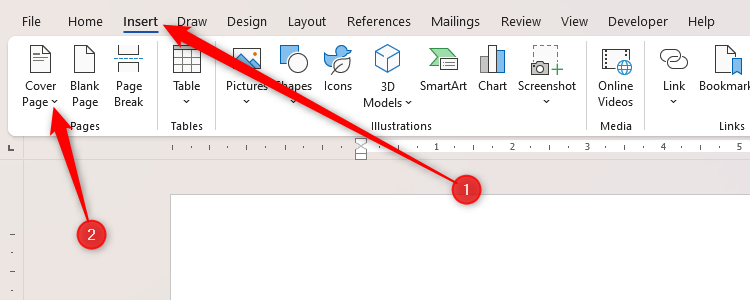
While this might be a good option if you're looking to save time, there are various reasons why it's not the best choice:
- Certain preset designs are overused. Similar to well-known PowerPoint presentation designs or website templates, they look pre-designed and standard, lacking that personal touch.
- Designing your own title page means that you can create and follow your own formatting. If you add a preset cover page after finishing your work, you might find the layout is inconsistent with the remainder of your document.
- Word's preset cover pages contain placeholders where you position your text. While you can move, format, and resize these placeholders, they are created using text boxes (rather than as text on the page itself), so their structure is limiting and insecure.
- Depending on the type of document you are creating, you might want a plainer title page. Indeed, some of Word's fancier layouts would look out of place at the beginning of a formal academic document.
- You might find that the designs do not work for you. Creating your own title page offers more flexibility for displaying what you want, where you want it, and how you want it.
The first step to creating your impressive title page is to use or modify styles . You'll find a Title style in the Style Gallery (in the Home tab on the ribbon), which you can click before, during, or after typing your main document title.
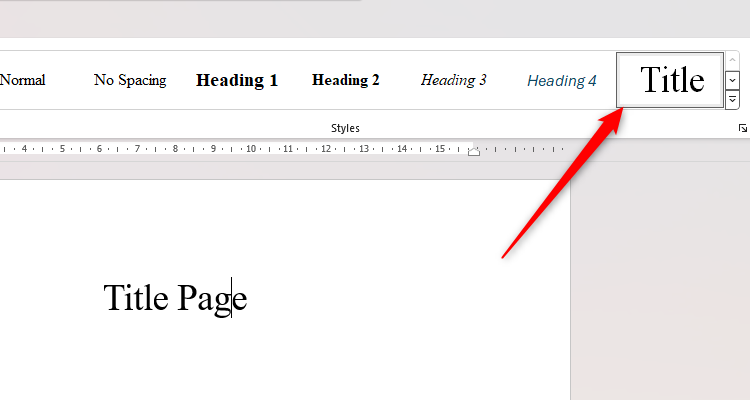
However, if you're not happy with the layout of the Title style, right-click "Title" in the Style Gallery, and click "Modify."
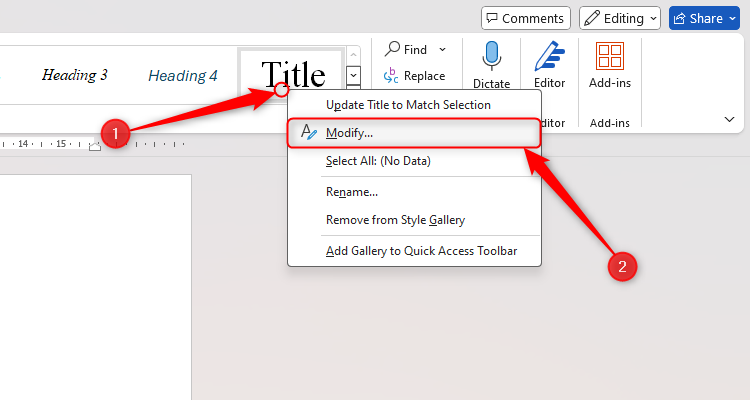
You can then change the style's settings to present your title as you wish. I'd recommend the following settings.
In the Modify Style dialog box, click Format > Font.
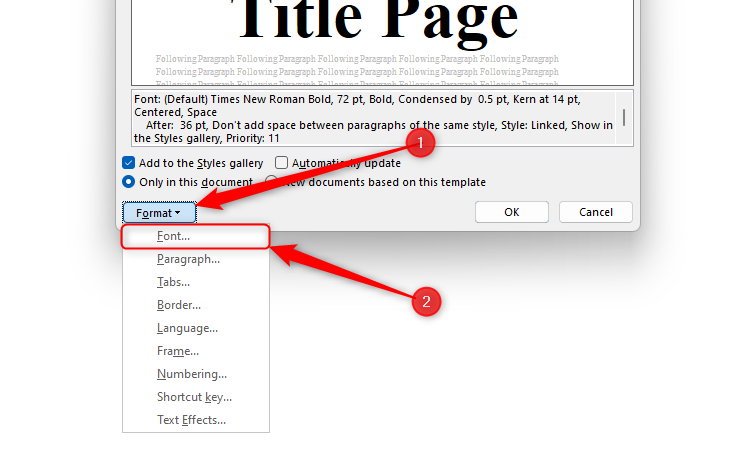
Here, change the font to bold and 72 pt (or a similarly large size, but not too big!). This will make your title really stand out.
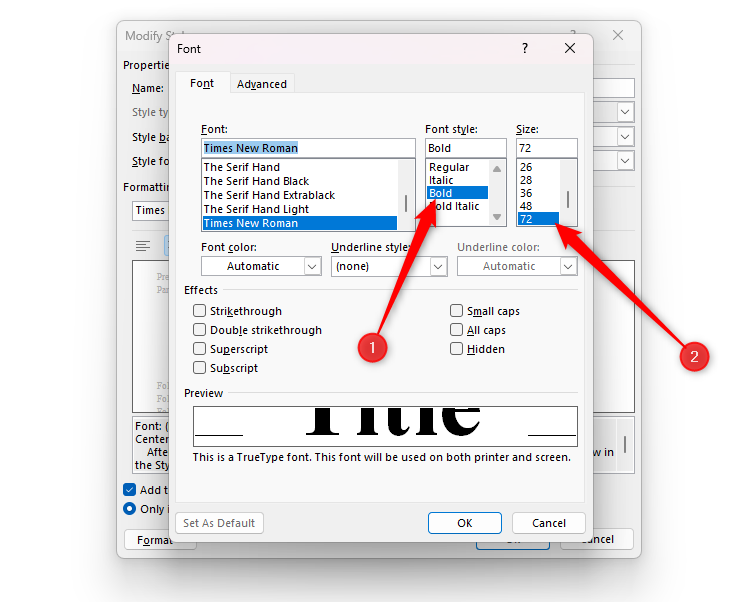
By default, Word condenses any text in the Title style to differentiate it from the rest of the text. However, since I've chosen a larger typeface, I don't need the text to be condensed. So, open the "Advanced" tab, change the Character Spacing to "Normal," and click "OK" to close your font settings.
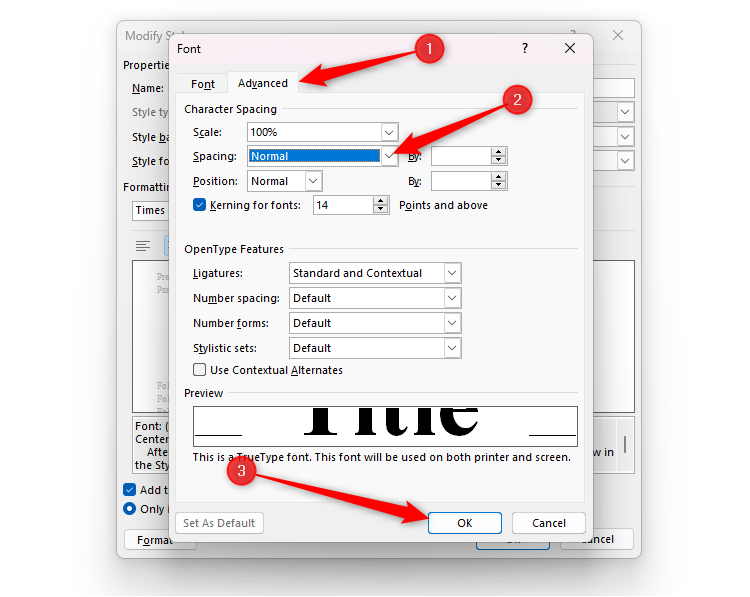
With the Modify Style dialog box still open, click Format > Paragraph to open the Paragraph dialog box. Here, change the Spacing After to half your chosen font size. So, since I have chosen size 72 pt font, I'll go with 36 pt for the spacing after the paragraph. Then, click "OK."
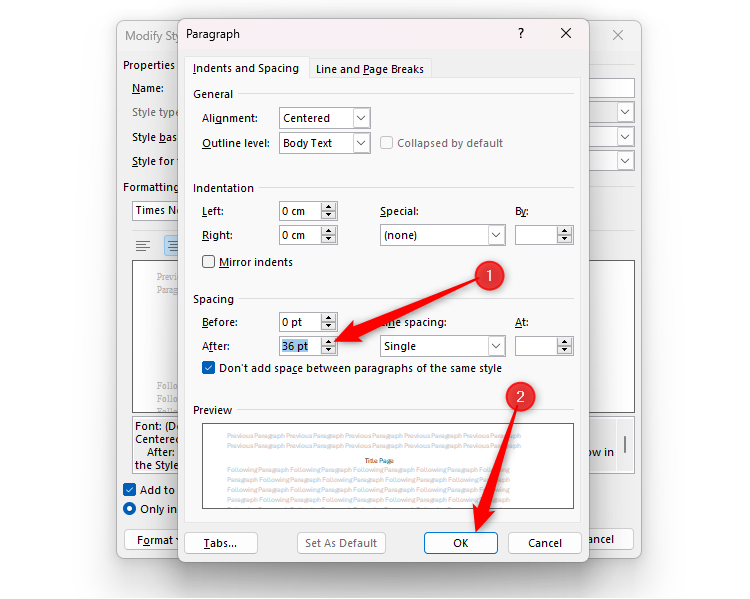
Before you close the Modify Style dialog box, decide on your title alignment. In my example, I'll go with center alignment, as this layout looks great on a cover page. Finally, click "OK."
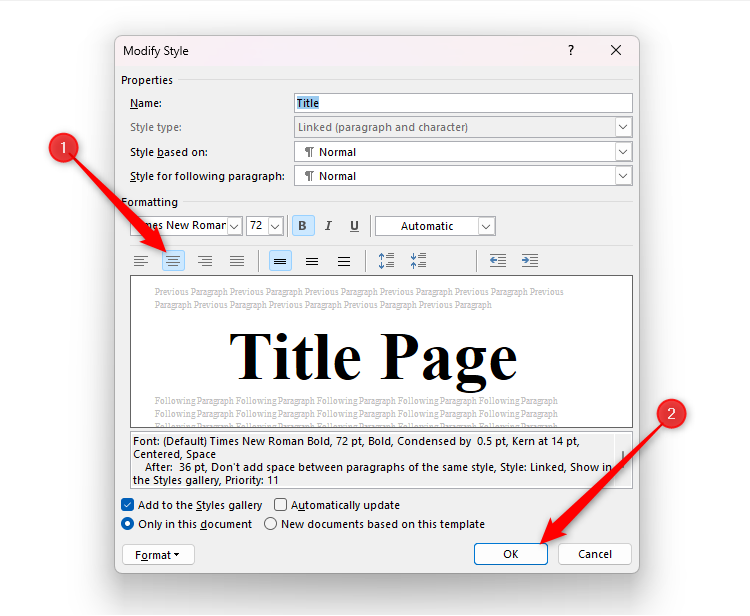
You can now press Enter and type further text beneath your title (such as your name, a second heading, or whatever you wish), and follow the same steps to decide on the style formatting. I've gone with Word's Intense Quote style and modified it to size 20 pt.
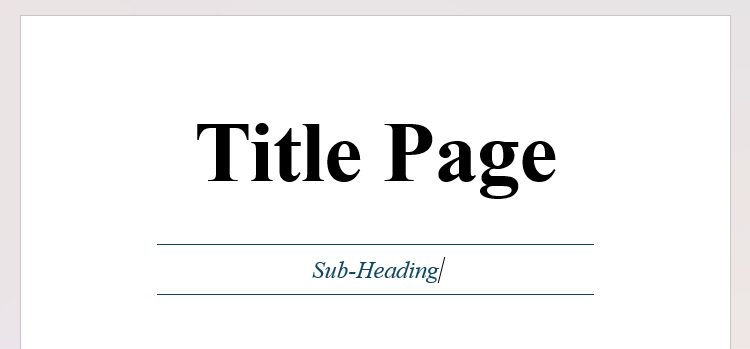
So that you can format your title page separately from the rest of your document, you need to add a Section Break . With your cursor at the end of the last word you have typed on the title page, click "Breaks" and then "Next Page" in the Layout tab on the ribbon.
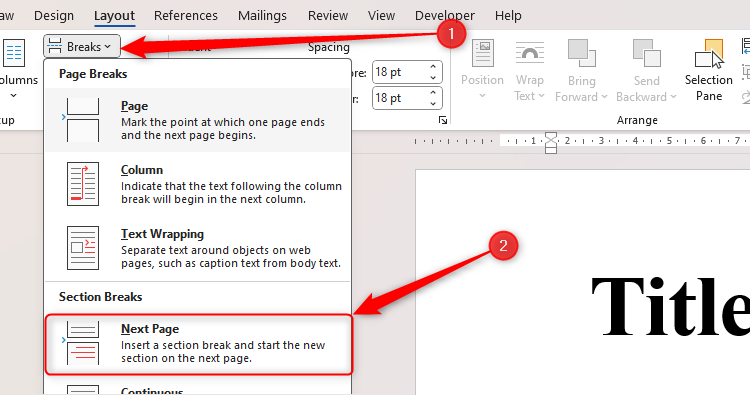
This will create a second page in your document, separated from your title page by an invisible section barrier. If you click the "Show/Hide" (¶) icon in the Home tab on the ribbon, you'll see where this Section Break is added. Click the ¶ icon again to hide these pagination markers.
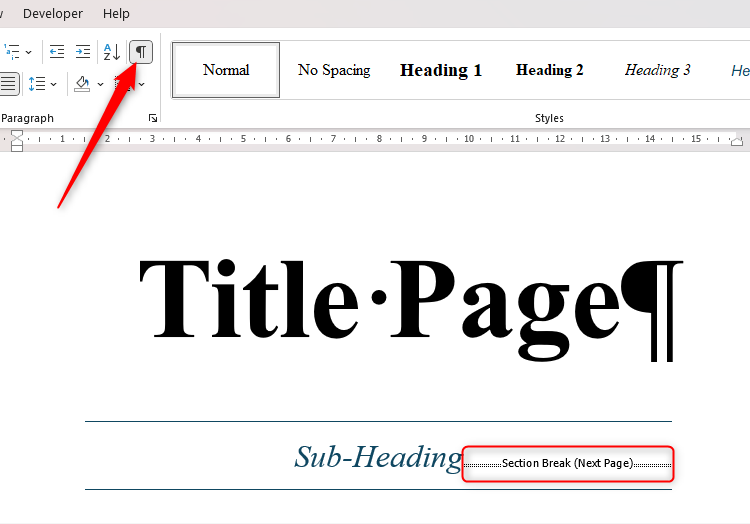
If you want to add more content to the title page, simply place your cursor before the Section Break, and press Enter. Word will then set the following line to the Normal style, ready for you to add more details.
A great title page always has a page border . To add one, place your cursor anywhere before the Section Break you just added, and click "Page Borders" in the design tab on the ribbon.
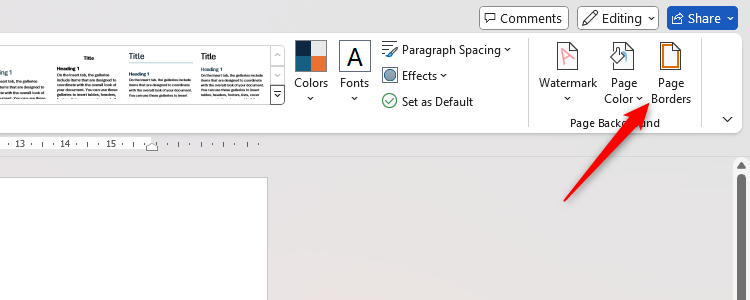
In the dialog box that opens, modify the border's Settings and Style to suit your needs. I've gone for a simple box and a solid, thin line, but you can design your border to your taste. Then, importantly, ensure you click the "Apply To" drop-down option and choose "This Section" or "This Section - First Page Only." This is why we created a Section Break in the previous step, and failing to choose this option will add page borders to every page in your document.
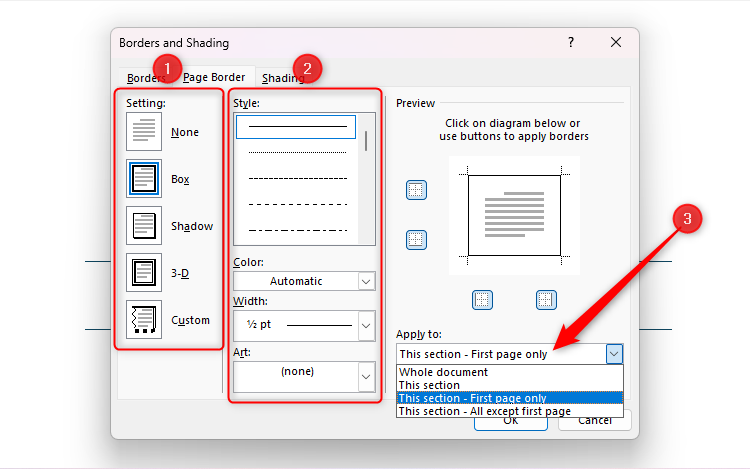
When you're done, click "OK" to see the outcome.
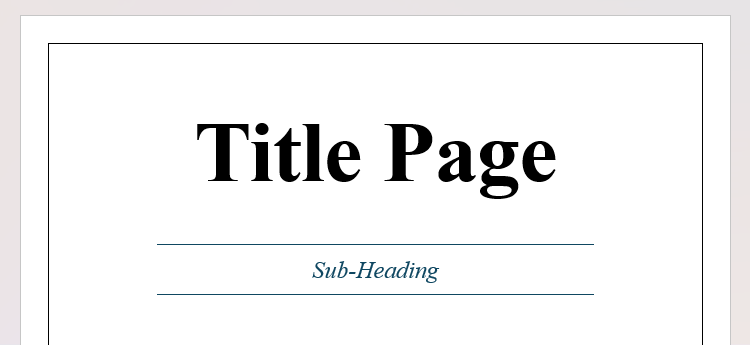
At the moment, the text is aligned at the top of the page, but a more professional title page will align the text in the center . To achieve this, with your cursor anywhere in the text you have typed so far, click the "Page Setup" icon in the corner of the Page Setup group in the Layout tab.
In the resulting dialog box, first, open the "Layout Tab." Then, click "Center" in the Vertical Alignment option, and choose "This Section" in the Apply To field. When you're done, click "OK."
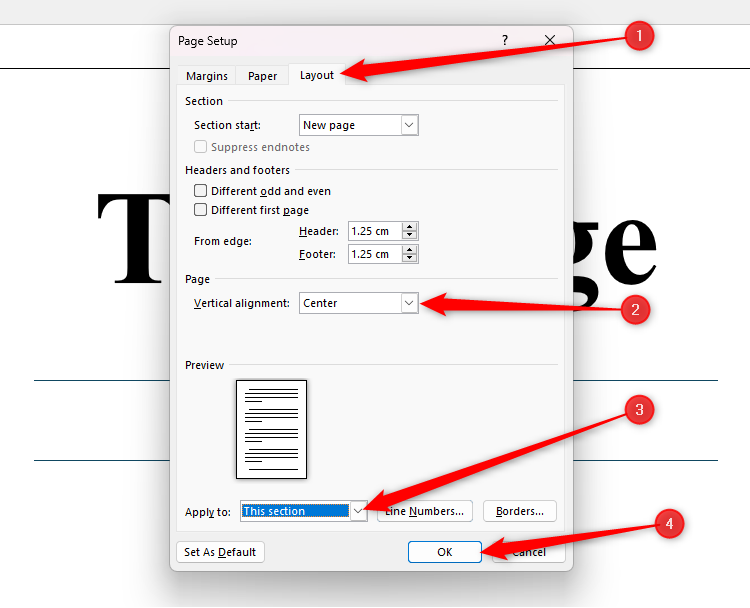
You will now see that your title page is nicely center-aligned.
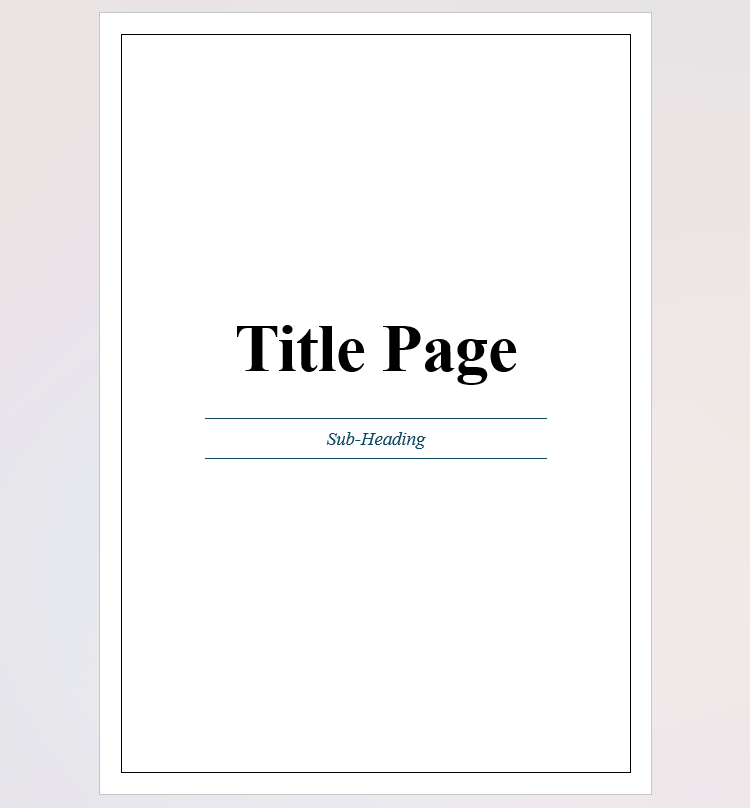
Title pages tend not to contain page numbers, so you need to change one more setting to make sure this doesn't happen when you add numbers to your subsequent pages .
Go to the second page (which you created when adding a Section Break to your title page), and double-click in the footer area.
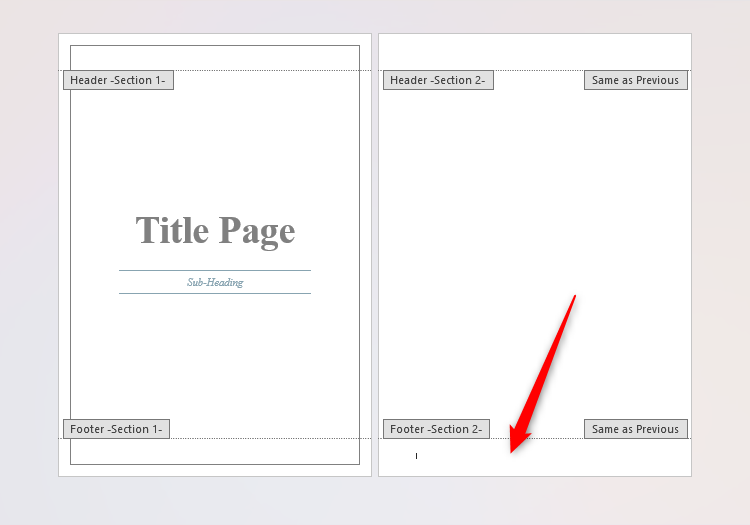
Then, in the "Header And Footer" tab on the ribbon, check "Different First Page."
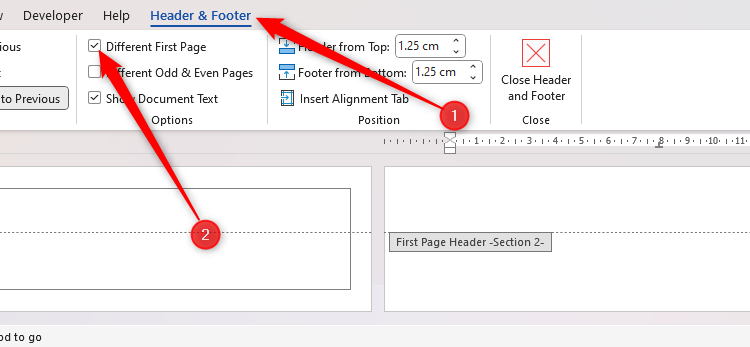
Now, in the same tab, click "Page Number," then "Bottom Of Page," and choose your preferred style. Personally, I always go for a centered page number.
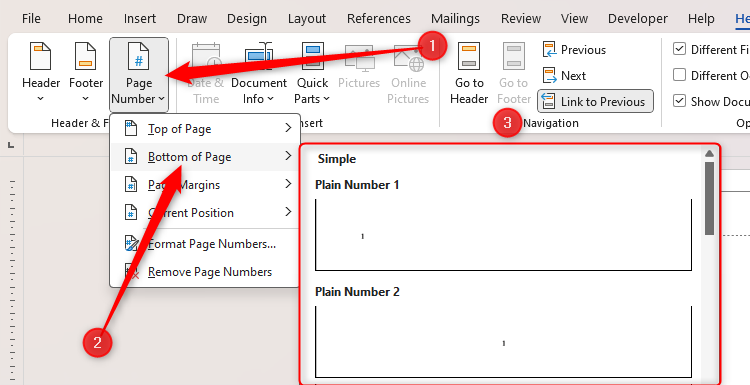
Since you told Word that your first-page footer is different from the rest of the document, you'll see that although your second page is numbered as page 2, there isn't a page number on your title page, keeping it clean and tidy without any unnecessary detail.
Now that you have an impressively formatted cover page, make sure you apply the necessary settings to make the rest of your document equally professional .
- Microsoft Word
- Microsoft 365
Generate accurate Chicago citations for free
- Knowledge Base
- Chicago Style
How to Format a Turabian/Chicago Style Title Page | Example
Published on October 10, 2019 by Jack Caulfield . Revised on April 9, 2024.
Turabian style , a version of Chicago style designed specifically for writing research papers , theses , and dissertations , provides detailed guidelines for formatting a title page.
A title page is not mandatory; if you haven’t been told to include one, you can just center your title at the top of the first page.
These are the key guidelines for creating a title page in Turabian style:
- Title and subtitle appear ⅓ of the way down the page.
- Other information (e.g., your name, the date, class information) appears ⅔ down the page.
- All text is center-aligned and double-spaced .
- No page number is included on the title page.
Chicago Citation Generator
Instantly correct all language mistakes in your text
Upload your document to correct all your mistakes in minutes

Table of contents
Chicago title page example, general formatting of the title page, placement and format of the title, placement and format of other information, frequently asked questions about chicago format.
Below is an example of a typical title page following Turabian guidelines:
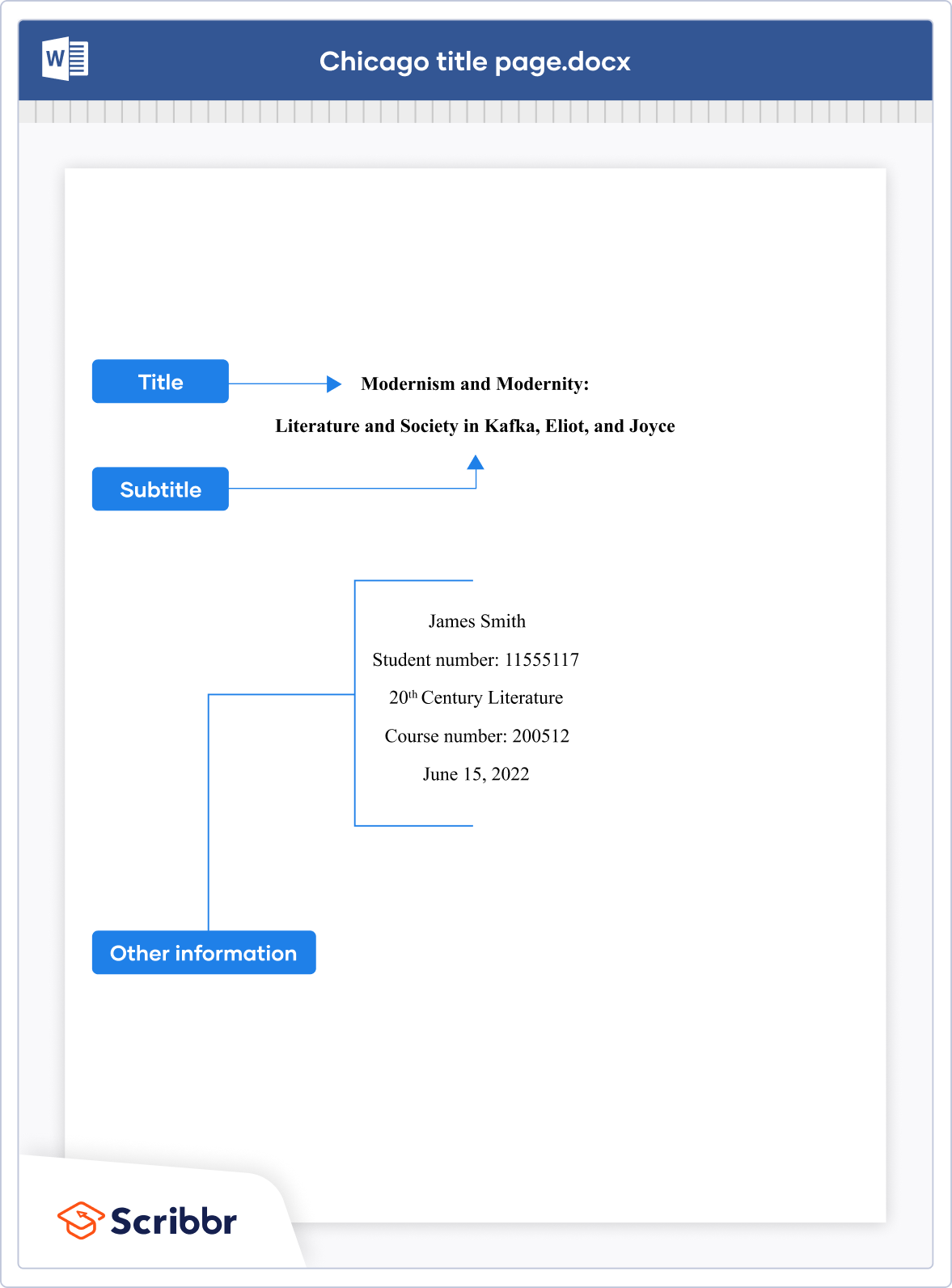
Here's why students love Scribbr's proofreading services
Discover proofreading & editing
The title page is the very first page of your text, appearing before the table of contents , acknowledgements , abstract , etc.
All text on your title page should be presented in the same font you use for the main text, center-aligned and double-spaced. The title page does not feature a page number, but it is included in the page count—that means that the following page should be page 2.
The title appears roughly ⅓ of the way down the page (it’s not important to be precise) in bold. It can also be written in a larger font size than the rest of the text, though this is optional.
Use headline capitalization, which means capitalizing all important words:
- Summary of results
- Summary of Results
If you have a subtitle, the main title should be followed by a colon, and the subtitle should appear on the next line. It should also appear in headline capitalization , in bold, and in the same font size as the main title.
Roughly ⅔ of the way down the page, add any other information your instructor or faculty requires you to include. This information should not be in bold, and should be in the same font size as your main text. Each new piece of information appears on a new line.
This might include your name, student number, the course name and number, and/or your instructor’s name, among other things. There’s no standard list of information to include, but you’ll usually be told clearly by your university what needs to be here.
Turabian style is a version of Chicago style designed specifically for students and researchers. It follows most Chicago conventions, but also adds extra guidelines for formatting research papers , theses and dissertations .
More information can be found in A Manual for Writers of Research Papers, Theses, and Dissertations by Kate L. Turabian, now in its ninth edition.
Chicago format doesn’t require you to use any specific font, as long as you choose something readable. A good standard choice is 12 pt Times New Roman.
Cite this Scribbr article
If you want to cite this source, you can copy and paste the citation or click the “Cite this Scribbr article” button to automatically add the citation to our free Citation Generator.
Caulfield, J. (2024, April 09). How to Format a Turabian/Chicago Style Title Page | Example. Scribbr. Retrieved July 30, 2024, from https://www.scribbr.com/chicago-style/turabian-title-page/
Is this article helpful?

Jack Caulfield
Other students also liked, chicago style format for papers | requirements & examples, creating a chicago style bibliography | format & examples, chicago in-text citations | styles, format & examples, what is your plagiarism score.
Steps on How to Make a Title Page for a Research Paper

Research Paper Title Page
A title page is the first thing that your instructor sees when looking at your document; therefore, it is essential for a student to invest in making it look consistent and professional. It is vital for students to learn how to format a title page of a research paper if they want to create an excellent first impression with the examiner. As you craft your title page, you should focus on reflecting what is in your paper. Here our professionals constructed a detailed guide for you to help with that title page.
What Is a Research Paper Title Page and How Do You Structure It?
A research paper title page is the first page of your research paper. It is essential to come up with a title page that gives the readers an overview of the research. It should also be structured in a way that gives it a professional outlook.
A title page should include a running head, research paper title, page number, student’s name, and student’s affiliations. There are three styles one can use to structure a title page in academic writing. Depending on the instructions given by the teacher, you can use APA, MLA or Chicago style to format your title page. Research paper title pages are easy and straightforward to make. With the help of a guideline, a student can draft a title page that meets the teacher’s instructions. Below is a step-by-step guide on how to develop a research paper title page:
- Start with the title page which is written a third way down on the document. The heading should be aligned at the center. Once you have written the title leave two spaces and write your name. Type your first name, middle initials, and last name.
- Write your full official names and do not include any title before or after your name. If the research paper, was a group effort, remember to include the name of the others. Separate each name with a comma.
- Include the name of your institution. Write the full name of your school. In case the paper was drafted by more than one individual from different institutions after the name of each writer, the name of their respective school should be typed.
- Type the name of the course and also the course code. The date of submission is optional; however, if you choose to include it, you should do so after writing the course title.
Basic Rules on How to Make a Research Paper Title Page
When writing a title page, there are some factors that one should keep in mind regardless of the formatting style you are using. If students want to obtain a well-written title page, they should adhere to the following rules:
- While formatting your work see to it that the entire text in the title page is aligned at the center. Also, keep your work double-spaced and the margin set at one inch on all sides.
- It is essential to keep your work well organized and readable. Therefore, ensure you use a clear and legible font. A preferable font to use is the News-Times Roman at 12 points.
- Use correct capitalization, except when writing short words like prepositions and conjunctions you can use lower case.
- When writing a research paper, numbering your work is a requirement, and that also includes the title page. Insert a running head on the right-hand top of the page and the page number of the left top of the page.
- Develop a brief and concise title that is relevant to the content in your research paper. Remove any extraneous words that do not add meaning to it. Craft an intriguing heading that will hook your readers to the research paper.
Employing these tips will assist any college student to write an impressive title page. Those who lack time to draft their papers can ask our custom writing service for help. Our company has extensive experience working on various academic tasks for students. With our team of experts, we see to it that clients get services that worth their money. We have a quality assurance department that guarantees to review all orders to ensure they meet customers’ standards before they are submitted. Order our writing service packages offered at student-friendly prices.
During our years in the writing industry, we have familiarized with different academic writing styles, and we can customize a title page as per your preference. Our research paper service has a strict confidentiality policy that assures customers to keep their information private.
Get an instant quote

The Guide to Literature Reviews

- What is a Literature Review?
- The Purpose of Literature Reviews
- Guidelines for Writing a Literature Review
- How to Organize a Literature Review?
- Software for Literature Reviews
- Using Artificial Intelligence for Literature Reviews
- How to Conduct a Literature Review?
- Common Mistakes and Pitfalls in a Literature Review
- Methods for Literature Reviews
- What is a Systematic Literature Review?
- What is a Narrative Literature Review?
- What is a Descriptive Literature Review?
- What is a Scoping Literature Review?
- What is a Realist Literature Review?
- What is a Critical Literature Review?
- Meta Analysis vs. Literature Review
- What is an Umbrella Literature Review?
- Differences Between Annotated Bibliographies and Literature Reviews
- Literature Review vs. Theoretical Framework
- How to Write a Literature Review?
- How to Structure a Literature Review?
- How to Write a Literature Review Cover Page?
What is included in the cover page of a literature review research paper?
Formatting and writing tips.
- How to Write an Abstract for a Literature Review?
- How to Write a Literature Review Introduction?
- How to Write the Body of a Literature Review?
- How to Write a Literature Review Conclusion?
- How to Make a Literature Review Bibliography?
- How to Format a Literature Review?
- How Long Should a Literature Review Be?
- Examples of Literature Reviews
- How to Present a Literature Review?
- How to Publish a Literature Review?
How to Make a Cover Page for a Literature Review?
A literature review cover page is the first point of contact between your research paper and your readers. It serves as a critical element that introduces your work and sets the tone for the entire document. A well-designed cover page provides essential details such as the paper title, author’s name, institutional affiliation and submission date. These elements help to contextualize your work within the academic or professional environment and ensure that your paper is properly identified and attributed.

Adhering to specific formatting guidelines, such as those outlined in the APA 7th edition guidelines, demonstrates your attention to detail and your commitment to maintaining high academic standards. In this article, we will explore the purpose and components of a literature review cover page, along with practical tips for creating an effective and professional-looking cover page. By following these guidelines, you can ensure that your literature review not only meets academic requirements but also makes a strong first impression on your readers.
The elements included in the cover page of a literature review can vary depending on the guidelines provided by your institution or the specific requirements of the publication. However, several key components are typically included:
Title of the literature review
The paper title should be centred and placed three to four lines down from the top margin of the page. It should be bold and written in the title case (capitalizing the first letter of major words). The title should be concise yet descriptive, clearly indicating the focus of your review.
Author’s name
Below the title, include your full name. If the review is a group effort, list all contributing authors. The names should be double-spaced and centred.
Institutional affiliation
Directly below the author’s name, include the name of your institution or organization. This helps contextualize your work within the academic or professional environment.
Date of submission
Finally, include the due date when the literature review is submitted. The date should be formatted appropriately (e.g., June 23, 2024) and placed below the author's institutional affiliation.

Quality literature reviews start with ATLAS.ti
From research question to writing your bibliography, ATLAS.ti is there for you at every step. See how with a free trial.
Creating a well-formatted and professional cover page requires attention to detail and adherence to specific formatting guidelines. Here are some tips based on APA format guidelines, though other formats exist and may be used depending on institutional requirements:
Use standard fonts and sizes : Use a standard font like Times New Roman in a 12-point size. This ensures readability and a professional appearance.
Double-space all text : Double-spacing makes the cover page easier to read and provides a clean layout. Each section should be separated by a double-spaced blank line.
Set 1-inch margins on all sides : Consistent margins are important for a neat and organized look.
Center all text on the cover page : Centering the text helps create a balanced and visually appealing page.
Follow specific guidelines : Always check for any specific formatting requirements provided by your institution or publication. This includes any instructions on the order and placement of information.
Include a running head and page number : For APA format, include a running head in the page header, aligned to the left, and a page number aligned to the right.
Be concise and clear : The title should be clear and concise, providing an accurate representation of your literature review's content. Avoid using jargon or overly complex language.
Consult the publication manual : Refer to the APA style guide or the specific publication manual for detailed instructions on formatting.
By following these guidelines based on APA 7th edition, you can create a well-formatted and professional cover page for your literature review. The cover page is the first thing your readers see, so it is important to make a good impression. A well-crafted cover page sets the stage for the rest of your work and demonstrates your attention to detail and adherence to academic standards.
American Psychological Association. (2020). Publication Manual of the American Psychological Association (7th ed.). American Psychological Association.
Develop powerful literature reviews with ATLAS.ti
Use our intuitive data analysis platform to make the most of your literature review.

How to Write a Research Proposal: (with Examples & Templates)

Table of Contents
Before conducting a study, a research proposal should be created that outlines researchers’ plans and methodology and is submitted to the concerned evaluating organization or person. Creating a research proposal is an important step to ensure that researchers are on track and are moving forward as intended. A research proposal can be defined as a detailed plan or blueprint for the proposed research that you intend to undertake. It provides readers with a snapshot of your project by describing what you will investigate, why it is needed, and how you will conduct the research.
Your research proposal should aim to explain to the readers why your research is relevant and original, that you understand the context and current scenario in the field, have the appropriate resources to conduct the research, and that the research is feasible given the usual constraints.
This article will describe in detail the purpose and typical structure of a research proposal , along with examples and templates to help you ace this step in your research journey.
What is a Research Proposal ?
A research proposal¹ ,² can be defined as a formal report that describes your proposed research, its objectives, methodology, implications, and other important details. Research proposals are the framework of your research and are used to obtain approvals or grants to conduct the study from various committees or organizations. Consequently, research proposals should convince readers of your study’s credibility, accuracy, achievability, practicality, and reproducibility.
With research proposals , researchers usually aim to persuade the readers, funding agencies, educational institutions, and supervisors to approve the proposal. To achieve this, the report should be well structured with the objectives written in clear, understandable language devoid of jargon. A well-organized research proposal conveys to the readers or evaluators that the writer has thought out the research plan meticulously and has the resources to ensure timely completion.
Purpose of Research Proposals
A research proposal is a sales pitch and therefore should be detailed enough to convince your readers, who could be supervisors, ethics committees, universities, etc., that what you’re proposing has merit and is feasible . Research proposals can help students discuss their dissertation with their faculty or fulfill course requirements and also help researchers obtain funding. A well-structured proposal instills confidence among readers about your ability to conduct and complete the study as proposed.
Research proposals can be written for several reasons:³
- To describe the importance of research in the specific topic
- Address any potential challenges you may encounter
- Showcase knowledge in the field and your ability to conduct a study
- Apply for a role at a research institute
- Convince a research supervisor or university that your research can satisfy the requirements of a degree program
- Highlight the importance of your research to organizations that may sponsor your project
- Identify implications of your project and how it can benefit the audience
What Goes in a Research Proposal?
Research proposals should aim to answer the three basic questions—what, why, and how.
The What question should be answered by describing the specific subject being researched. It should typically include the objectives, the cohort details, and the location or setting.
The Why question should be answered by describing the existing scenario of the subject, listing unanswered questions, identifying gaps in the existing research, and describing how your study can address these gaps, along with the implications and significance.
The How question should be answered by describing the proposed research methodology, data analysis tools expected to be used, and other details to describe your proposed methodology.
Research Proposal Example
Here is a research proposal sample template (with examples) from the University of Rochester Medical Center. 4 The sections in all research proposals are essentially the same although different terminology and other specific sections may be used depending on the subject.

Structure of a Research Proposal
If you want to know how to make a research proposal impactful, include the following components:¹
1. Introduction
This section provides a background of the study, including the research topic, what is already known about it and the gaps, and the significance of the proposed research.
2. Literature review
This section contains descriptions of all the previous relevant studies pertaining to the research topic. Every study cited should be described in a few sentences, starting with the general studies to the more specific ones. This section builds on the understanding gained by readers in the Introduction section and supports it by citing relevant prior literature, indicating to readers that you have thoroughly researched your subject.
3. Objectives
Once the background and gaps in the research topic have been established, authors must now state the aims of the research clearly. Hypotheses should be mentioned here. This section further helps readers understand what your study’s specific goals are.
4. Research design and methodology
Here, authors should clearly describe the methods they intend to use to achieve their proposed objectives. Important components of this section include the population and sample size, data collection and analysis methods and duration, statistical analysis software, measures to avoid bias (randomization, blinding), etc.
5. Ethical considerations
This refers to the protection of participants’ rights, such as the right to privacy, right to confidentiality, etc. Researchers need to obtain informed consent and institutional review approval by the required authorities and mention this clearly for transparency.
6. Budget/funding
Researchers should prepare their budget and include all expected expenditures. An additional allowance for contingencies such as delays should also be factored in.
7. Appendices
This section typically includes information that supports the research proposal and may include informed consent forms, questionnaires, participant information, measurement tools, etc.
8. Citations

Important Tips for Writing a Research Proposal
Writing a research proposal begins much before the actual task of writing. Planning the research proposal structure and content is an important stage, which if done efficiently, can help you seamlessly transition into the writing stage. 3,5
The Planning Stage
- Manage your time efficiently. Plan to have the draft version ready at least two weeks before your deadline and the final version at least two to three days before the deadline.
- What is the primary objective of your research?
- Will your research address any existing gap?
- What is the impact of your proposed research?
- Do people outside your field find your research applicable in other areas?
- If your research is unsuccessful, would there still be other useful research outcomes?
The Writing Stage
- Create an outline with main section headings that are typically used.
- Focus only on writing and getting your points across without worrying about the format of the research proposal , grammar, punctuation, etc. These can be fixed during the subsequent passes. Add details to each section heading you created in the beginning.
- Ensure your sentences are concise and use plain language. A research proposal usually contains about 2,000 to 4,000 words or four to seven pages.
- Don’t use too many technical terms and abbreviations assuming that the readers would know them. Define the abbreviations and technical terms.
- Ensure that the entire content is readable. Avoid using long paragraphs because they affect the continuity in reading. Break them into shorter paragraphs and introduce some white space for readability.
- Focus on only the major research issues and cite sources accordingly. Don’t include generic information or their sources in the literature review.
- Proofread your final document to ensure there are no grammatical errors so readers can enjoy a seamless, uninterrupted read.
- Use academic, scholarly language because it brings formality into a document.
- Ensure that your title is created using the keywords in the document and is neither too long and specific nor too short and general.
- Cite all sources appropriately to avoid plagiarism.
- Make sure that you follow guidelines, if provided. This includes rules as simple as using a specific font or a hyphen or en dash between numerical ranges.
- Ensure that you’ve answered all questions requested by the evaluating authority.
Key Takeaways
Here’s a summary of the main points about research proposals discussed in the previous sections:
- A research proposal is a document that outlines the details of a proposed study and is created by researchers to submit to evaluators who could be research institutions, universities, faculty, etc.
- Research proposals are usually about 2,000-4,000 words long, but this depends on the evaluating authority’s guidelines.
- A good research proposal ensures that you’ve done your background research and assessed the feasibility of the research.
- Research proposals have the following main sections—introduction, literature review, objectives, methodology, ethical considerations, and budget.

Frequently Asked Questions
Q1. How is a research proposal evaluated?
A1. In general, most evaluators, including universities, broadly use the following criteria to evaluate research proposals . 6
- Significance —Does the research address any important subject or issue, which may or may not be specific to the evaluator or university?
- Content and design —Is the proposed methodology appropriate to answer the research question? Are the objectives clear and well aligned with the proposed methodology?
- Sample size and selection —Is the target population or cohort size clearly mentioned? Is the sampling process used to select participants randomized, appropriate, and free of bias?
- Timing —Are the proposed data collection dates mentioned clearly? Is the project feasible given the specified resources and timeline?
- Data management and dissemination —Who will have access to the data? What is the plan for data analysis?
Q2. What is the difference between the Introduction and Literature Review sections in a research proposal ?
A2. The Introduction or Background section in a research proposal sets the context of the study by describing the current scenario of the subject and identifying the gaps and need for the research. A Literature Review, on the other hand, provides references to all prior relevant literature to help corroborate the gaps identified and the research need.
Q3. How long should a research proposal be?
A3. Research proposal lengths vary with the evaluating authority like universities or committees and also the subject. Here’s a table that lists the typical research proposal lengths for a few universities.
| Arts programs | 1,000-1,500 | |
| University of Birmingham | Law School programs | 2,500 |
| PhD | 2,500 | |
| 2,000 | ||
| Research degrees | 2,000-3,500 |
Q4. What are the common mistakes to avoid in a research proposal ?
A4. Here are a few common mistakes that you must avoid while writing a research proposal . 7
- No clear objectives: Objectives should be clear, specific, and measurable for the easy understanding among readers.
- Incomplete or unconvincing background research: Background research usually includes a review of the current scenario of the particular industry and also a review of the previous literature on the subject. This helps readers understand your reasons for undertaking this research because you identified gaps in the existing research.
- Overlooking project feasibility: The project scope and estimates should be realistic considering the resources and time available.
- Neglecting the impact and significance of the study: In a research proposal , readers and evaluators look for the implications or significance of your research and how it contributes to the existing research. This information should always be included.
- Unstructured format of a research proposal : A well-structured document gives confidence to evaluators that you have read the guidelines carefully and are well organized in your approach, consequently affirming that you will be able to undertake the research as mentioned in your proposal.
- Ineffective writing style: The language used should be formal and grammatically correct. If required, editors could be consulted, including AI-based tools such as Paperpal , to refine the research proposal structure and language.
Thus, a research proposal is an essential document that can help you promote your research and secure funds and grants for conducting your research. Consequently, it should be well written in clear language and include all essential details to convince the evaluators of your ability to conduct the research as proposed.
This article has described all the important components of a research proposal and has also provided tips to improve your writing style. We hope all these tips will help you write a well-structured research proposal to ensure receipt of grants or any other purpose.
References
- Sudheesh K, Duggappa DR, Nethra SS. How to write a research proposal? Indian J Anaesth. 2016;60(9):631-634. Accessed July 15, 2024. https://www.ncbi.nlm.nih.gov/pmc/articles/PMC5037942/
- Writing research proposals. Harvard College Office of Undergraduate Research and Fellowships. Harvard University. Accessed July 14, 2024. https://uraf.harvard.edu/apply-opportunities/app-components/essays/research-proposals
- What is a research proposal? Plus how to write one. Indeed website. Accessed July 17, 2024. https://www.indeed.com/career-advice/career-development/research-proposal
- Research proposal template. University of Rochester Medical Center. Accessed July 16, 2024. https://www.urmc.rochester.edu/MediaLibraries/URMCMedia/pediatrics/research/documents/Research-proposal-Template.pdf
- Tips for successful proposal writing. Johns Hopkins University. Accessed July 17, 2024. https://research.jhu.edu/wp-content/uploads/2018/09/Tips-for-Successful-Proposal-Writing.pdf
- Formal review of research proposals. Cornell University. Accessed July 18, 2024. https://irp.dpb.cornell.edu/surveys/survey-assessment-review-group/research-proposals
- 7 Mistakes you must avoid in your research proposal. Aveksana (via LinkedIn). Accessed July 17, 2024. https://www.linkedin.com/pulse/7-mistakes-you-must-avoid-your-research-proposal-aveksana-cmtwf/
Paperpal is a comprehensive AI writing toolkit that helps students and researchers achieve 2x the writing in half the time. It leverages 21+ years of STM experience and insights from millions of research articles to provide in-depth academic writing, language editing, and submission readiness support to help you write better, faster.
Get accurate academic translations, rewriting support, grammar checks, vocabulary suggestions, and generative AI assistance that delivers human precision at machine speed. Try for free or upgrade to Paperpal Prime starting at US$19 a month to access premium features, including consistency, plagiarism, and 30+ submission readiness checks to help you succeed.
Experience the future of academic writing – Sign up to Paperpal and start writing for free!
Related Reads:
- How to Paraphrase Research Papers Effectively
- How to Cite Social Media Sources in Academic Writing?
- What is the Importance of a Concept Paper and How to Write It
APA format: Basic Guide for Researchers
You may also like, how to choose a dissertation topic, how to write a phd research proposal, how to write an academic paragraph (step-by-step guide), five things authors need to know when using..., 7 best referencing tools and citation management software..., maintaining academic integrity with paperpal’s generative ai writing..., research funding basics: what should a grant proposal..., how to write an abstract in research papers..., how to write dissertation acknowledgements.

IMAGES
VIDEO
COMMENTS
Student title page The student title page includes the paper title, author names (the byline), author affiliation, course number and name for which the paper is being submitted, instructor name, assignment due date, and page number, as shown in this example.
A guide to creating an APA title page for your paper, with a template and examples. Learn how to include your name, course, instructor, and date in APA style.
MLA title page format. To create an MLA format title page, list the following on separate lines, left-aligned at the top of the page: Then leave a few blank lines and list the title of the paper, centered and in title case, halfway down the page. All text should be double-spaced and in the same font as the rest of the paper.
The title page (or cover page) of your thesis, dissertation, or research paper should contain all the key information about your document. It usually
Student Paper Setup Guide This guide will help you set up an APA Style student paper. The basic setup directions apply to the entire paper. Annotated diagrams illustrate how to set up the major sections of a student paper: the title page or cover page, the text, tables and figures, and the reference list.
What is the title page for an APA paper? The APA title page is the first page of your academic paper that provides information on the title, author (s), professors, and institutions affiliated with your research paper. There are separate APA cover page formats for student and professional papers.
The title page (also known as the cover page) is the front page of your paper. It should contain: The running head, a header at the top of the page. The first page number. The title of the paper. Your name.
Student Title Page Guide NOTE: These guidelines should be used to create title pages for student papers. However, if instructors or institutions provide different guidance, students should abide by those directions.
In APA Style (7th edition), the cover page, or title page, should include: A running head (professional papers only) and page number. The title of the paper. The name of the author (s) The institutional affiliation. An author note; optional (professional papers only) A student paper should also include course information.
The title page includes the following elements: Page number, Paper title, Author, Author Affiliation, Course, Instructor, and Due Date. Remember, your instructor can include other requirements for your assignment. Refer to their instructions carefully. Your title page and paper is double-spaced. Use 1-inch margins.
An APA title page is a reader's first impression of a paper. There are two format types: professional and student. Learn how to create both with this guide.
Here are the steps you need to take to create the perfect MLA title page: At the top of the page, type the name of your high school, college, or university (if applicable). Skip down approximately one-third of the page and type the title of your research paper using title case.
Below are step-by-step instructions on how to format a student title page in APA, 7th edition. 1. First, use the Insert Page Number button on the Insert Tab of a Microsoft Word document to insert a plain page number at the right margin of the header.
Research Paper Title Page Research Paper Title Page is the cover page of a research paper that provides basic information about the paper. It typically includes the title of the research paper, the author's name, the date of submission, and the name of the institution or department where the research was conducted.
This article walks through the formatting steps needed to create an APA Style student paper, starting with a basic setup that applies to the entire paper (margins, font, line spacing, paragraph alignment and indentation, and page headers). It then covers formatting for the major sections of a student paper: the title page, the text, tables and ...
The research title is an important element of your research paper. Follow these steps to make the perfect title for your paper.
Almost all psychology writings require a title page. Learn how to write a title page in APA format for a psychology research paper and which elements to include.
What is a Research Paper Title? The title page of a research paper serves as its initial page, prominently displaying the paper's title or topic. This page previews the content of the research paper, setting the stage for the reader. Adherence to specific citation and formatting style guidelines is crucial in structuring the title page.
Research Paper Title Research Paper Title is the name or heading that summarizes the main theme or topic of a research paper. It serves as the first point of contact between the reader and the paper, providing an initial impression of the content, purpose, and scope of the research. A well-crafted research paper title should […]
Whether you're writing a book, a business plan, an academic paper, or a newsletter, a title page is a great way to capture your reader's attention, lay out what the document contains, and add professionalism to your work.
Turabian style, a version of Chicago style designed specifically for writing research papers, theses, and dissertations, provides detailed guidelines for formatting a title page.
A title page should include a running head, research paper title, page number, student's name, and student's affiliations. There are three styles one can use to structure a title page in academic writing.
A literature review cover page is the first point of contact between your research paper and your readers. It serves as a critical element that introduces your work and sets the tone for the entire document. A well-designed cover page provides essential details such as the paper title, author's name, institutional affiliation and submission date.
Find out what a research proposal is and when you should write it. This article also has expert tips and advice on how to write one, along with research proposal examples.